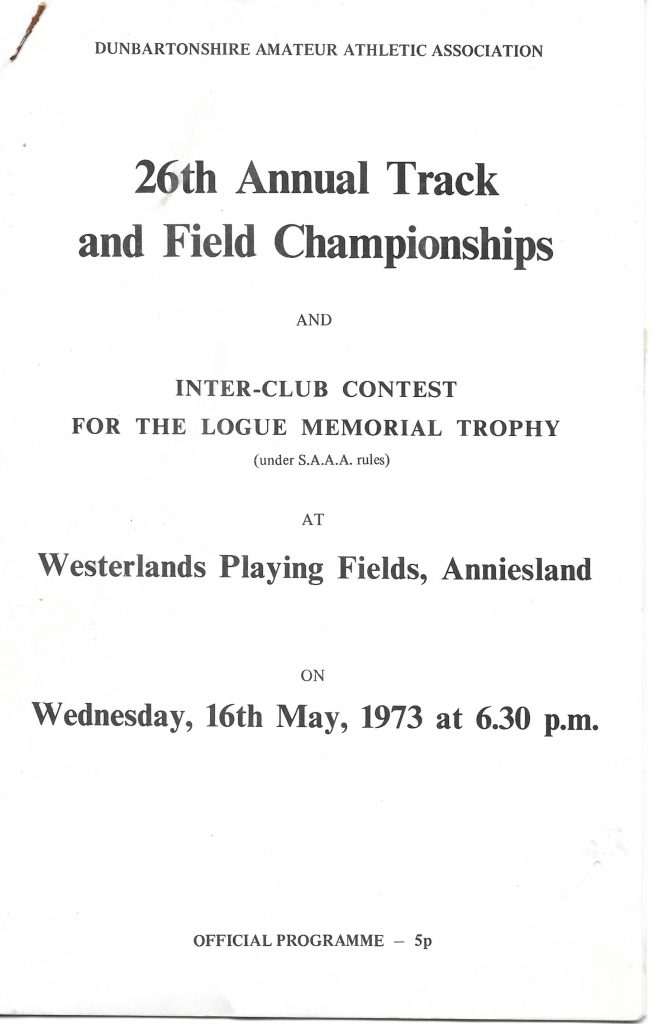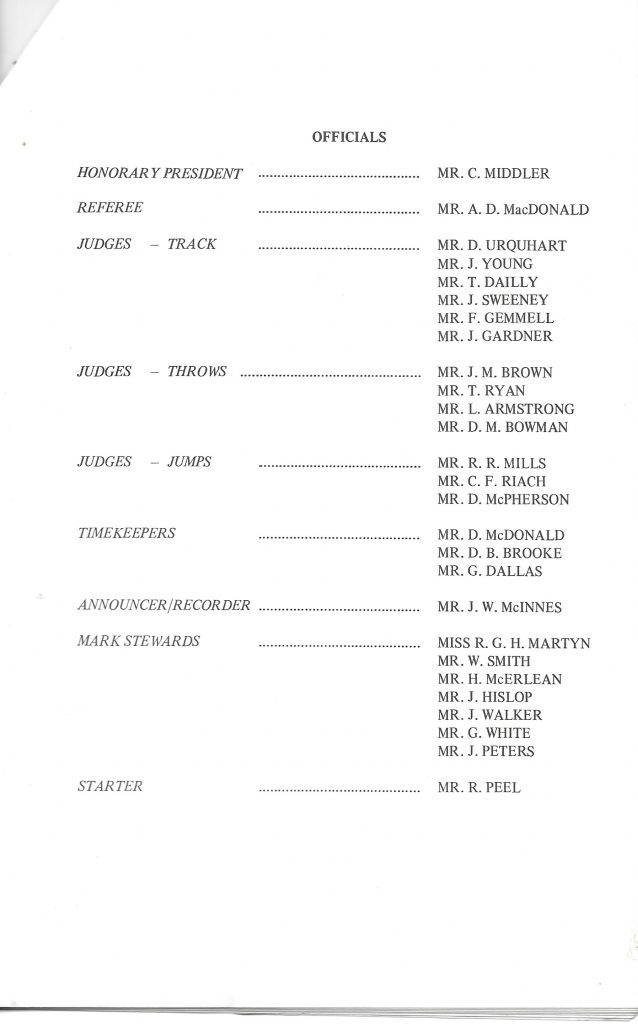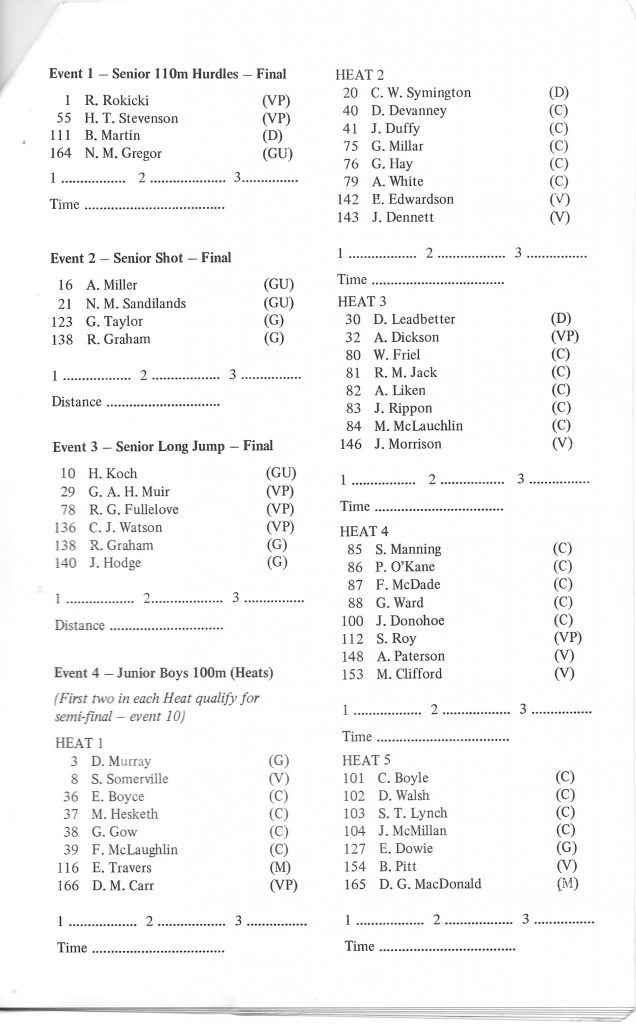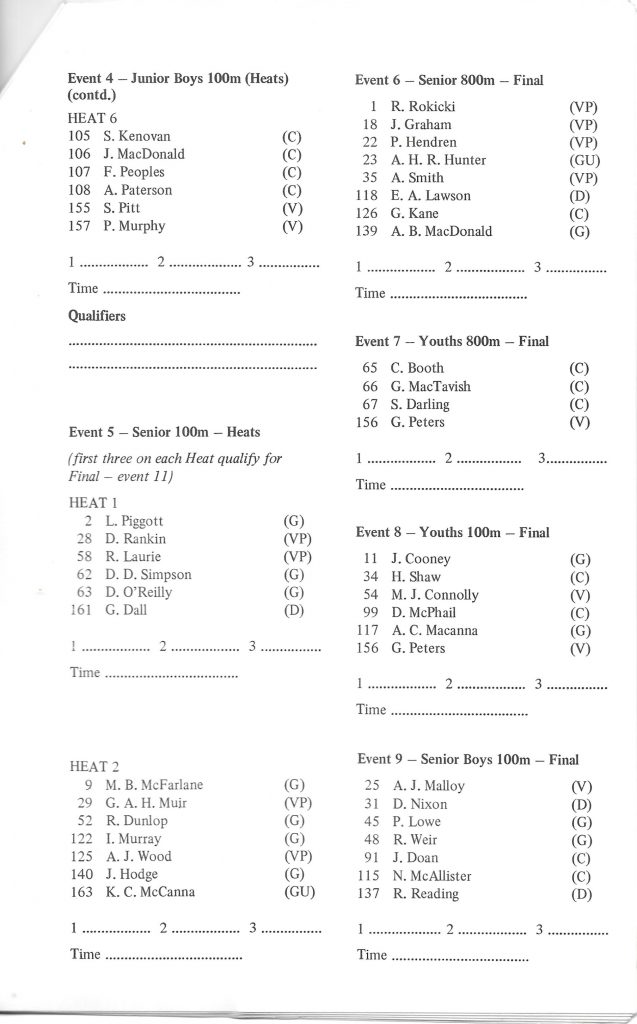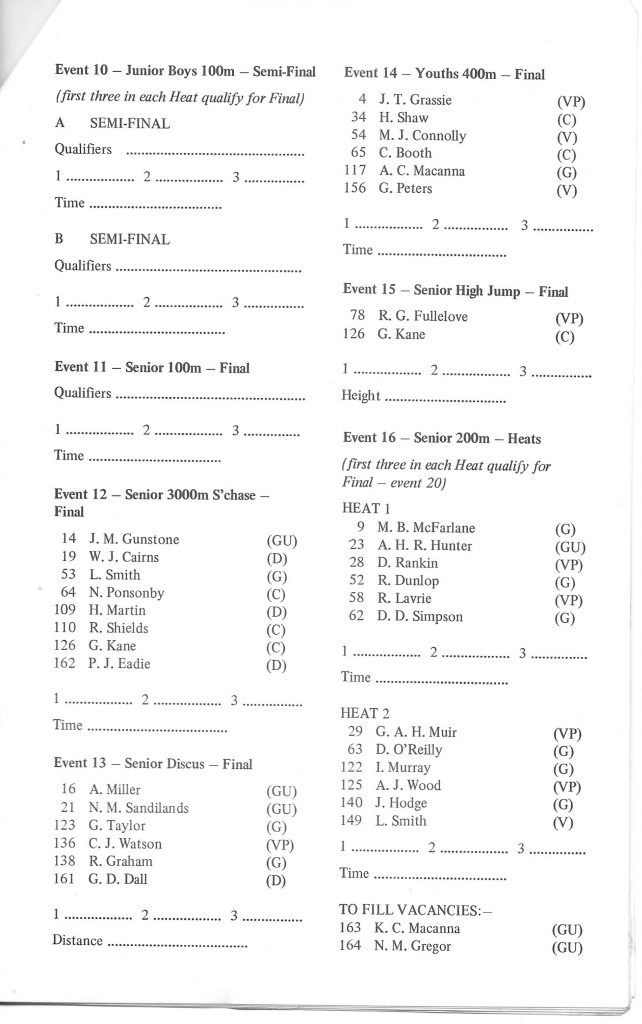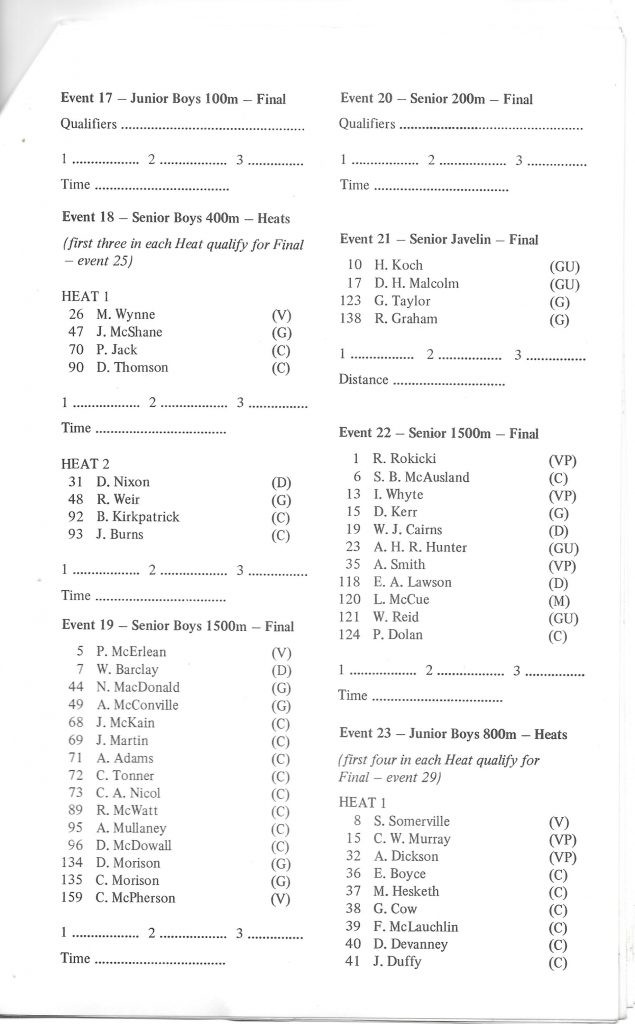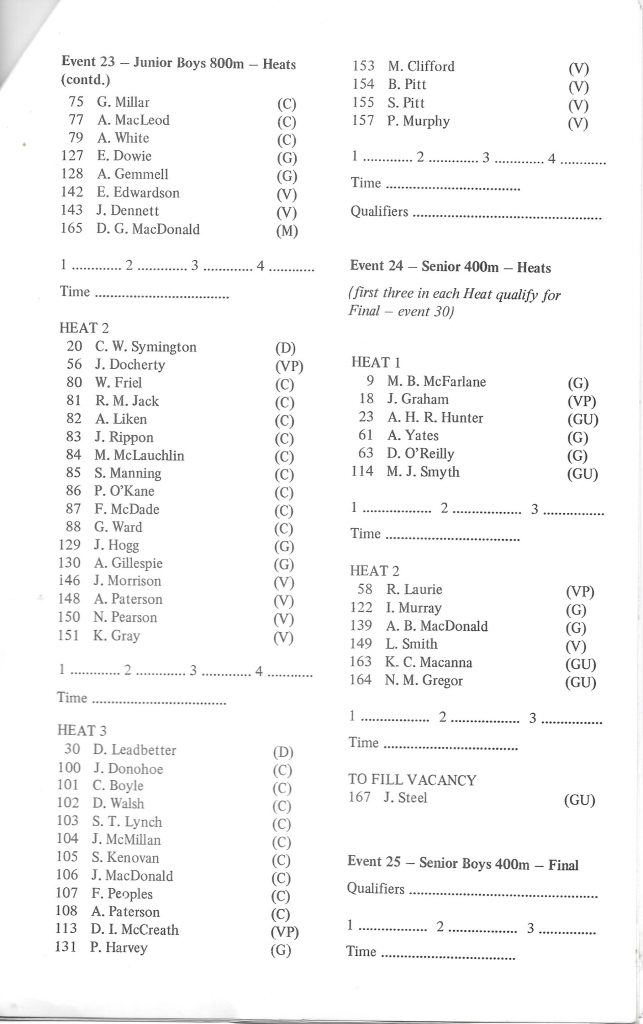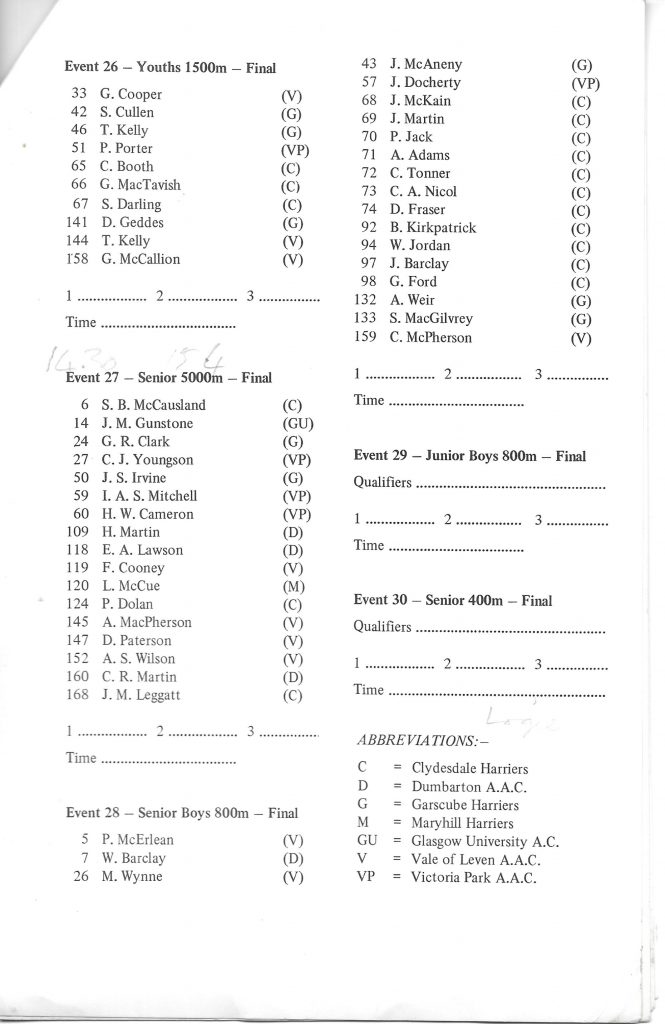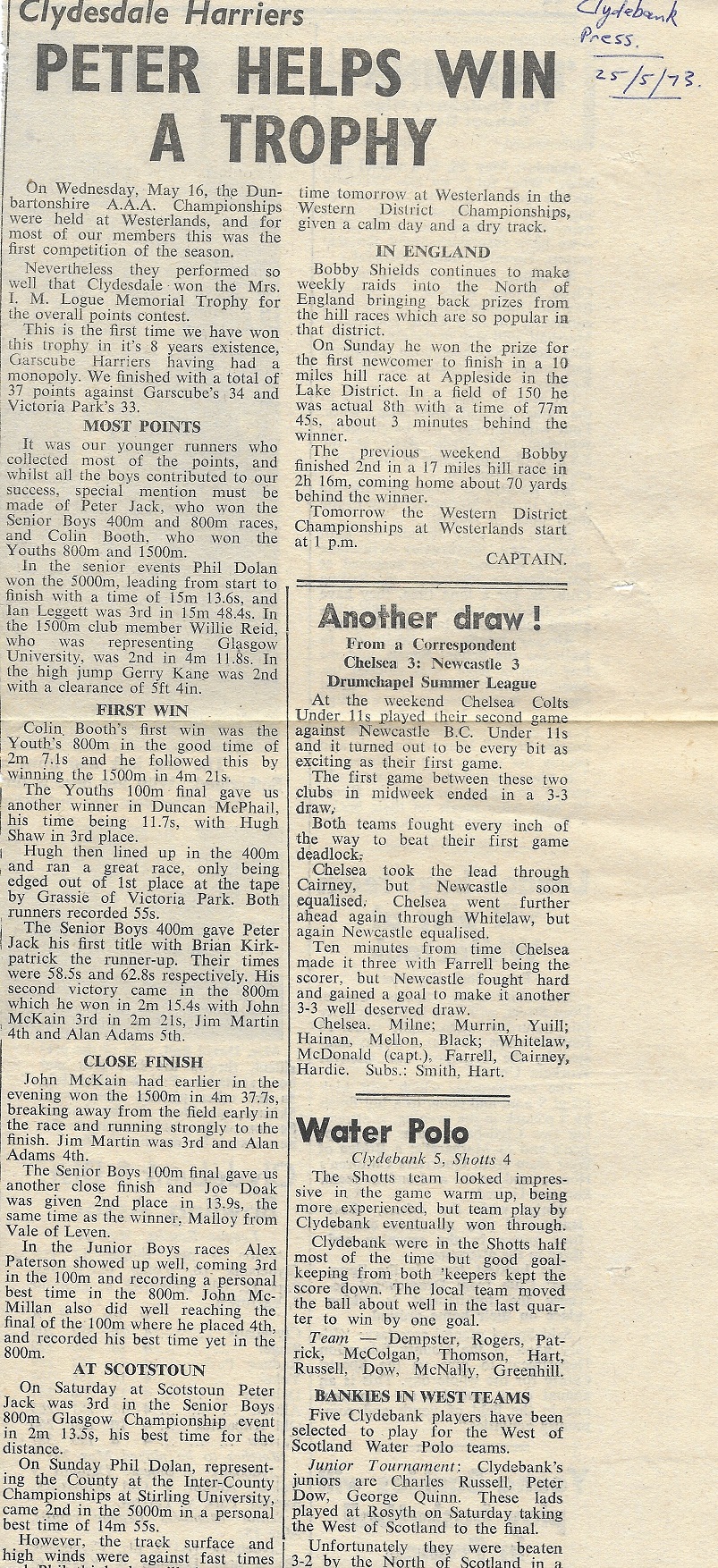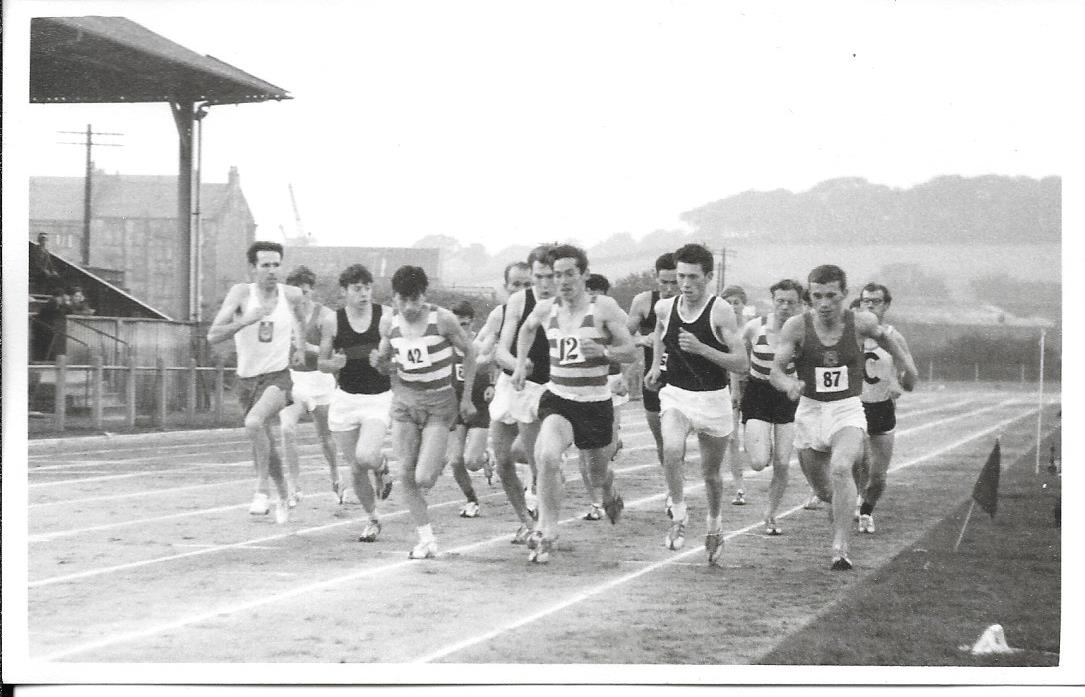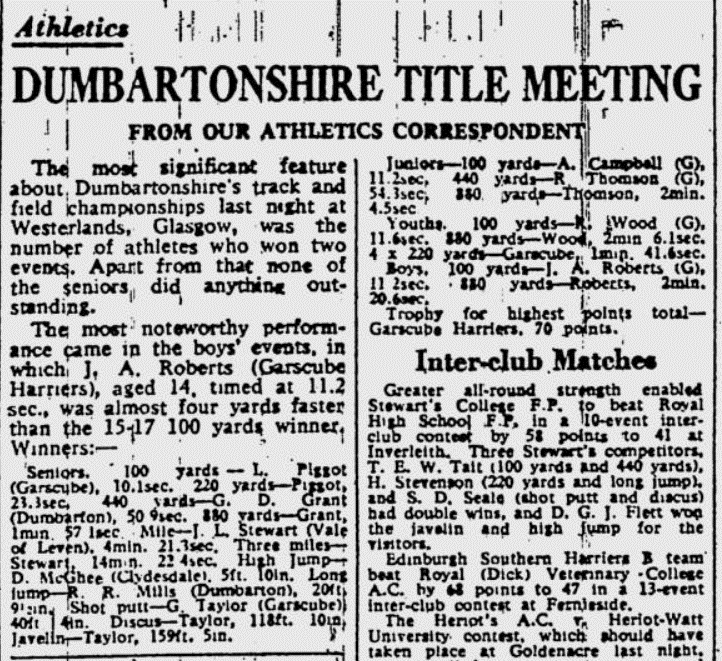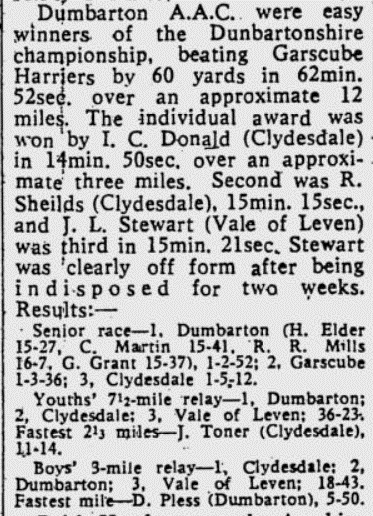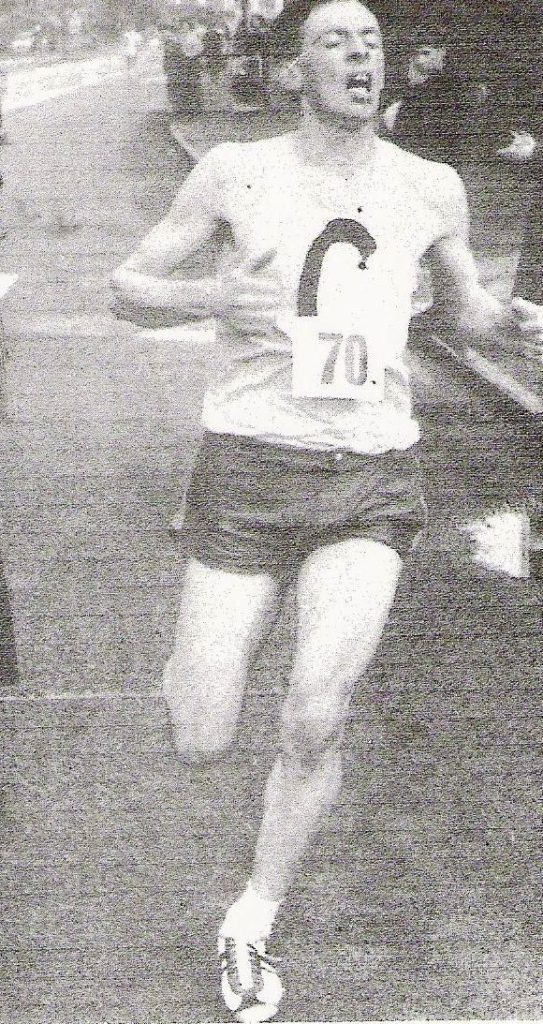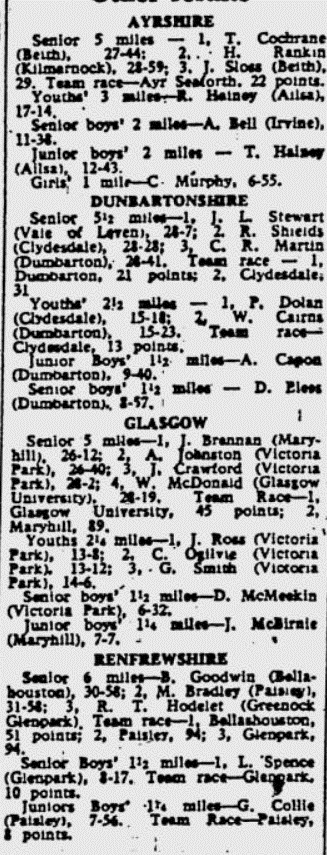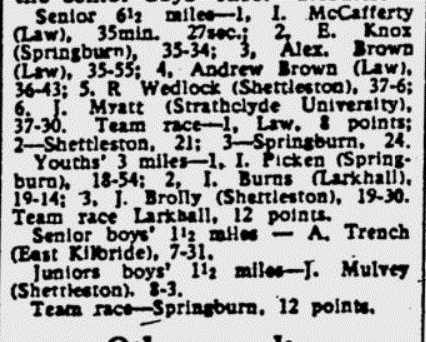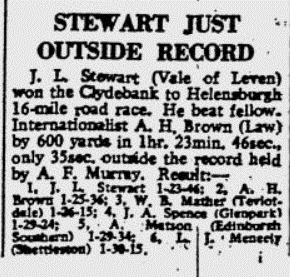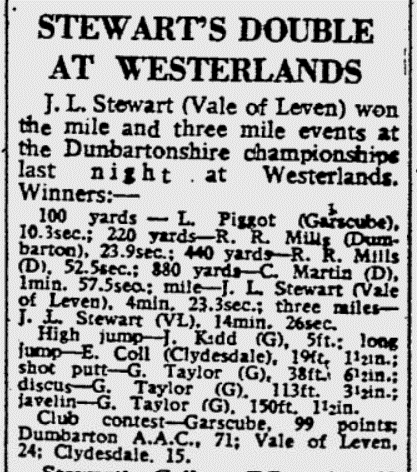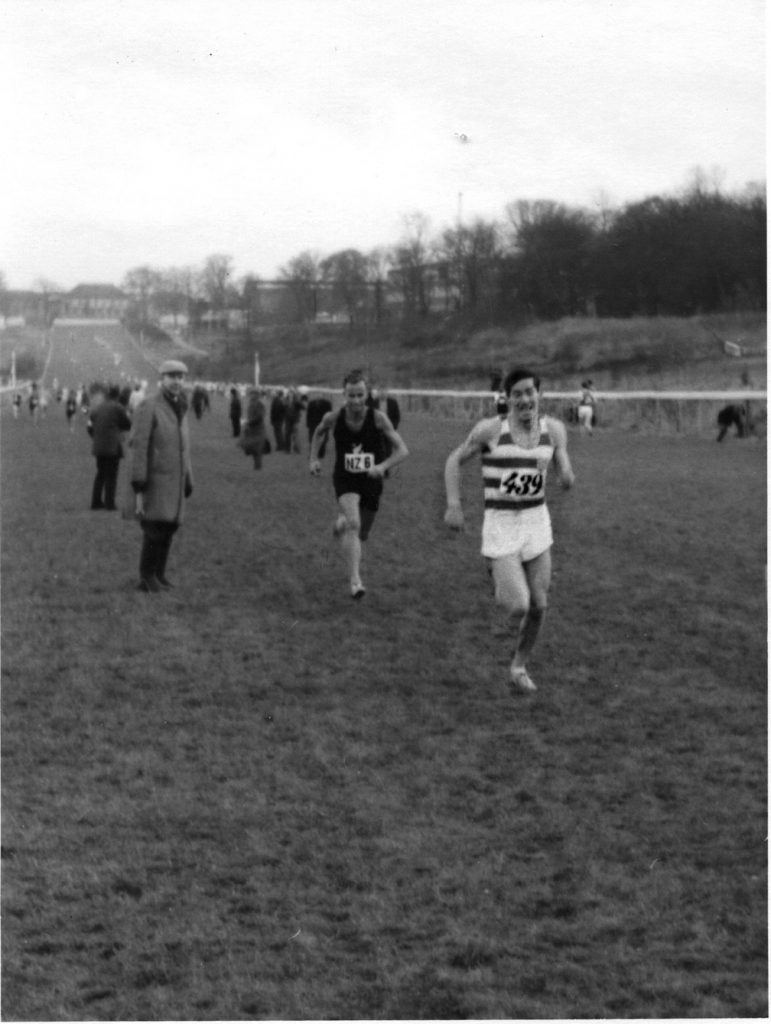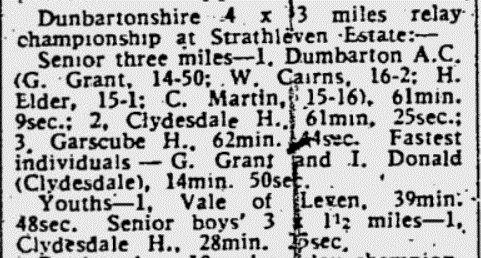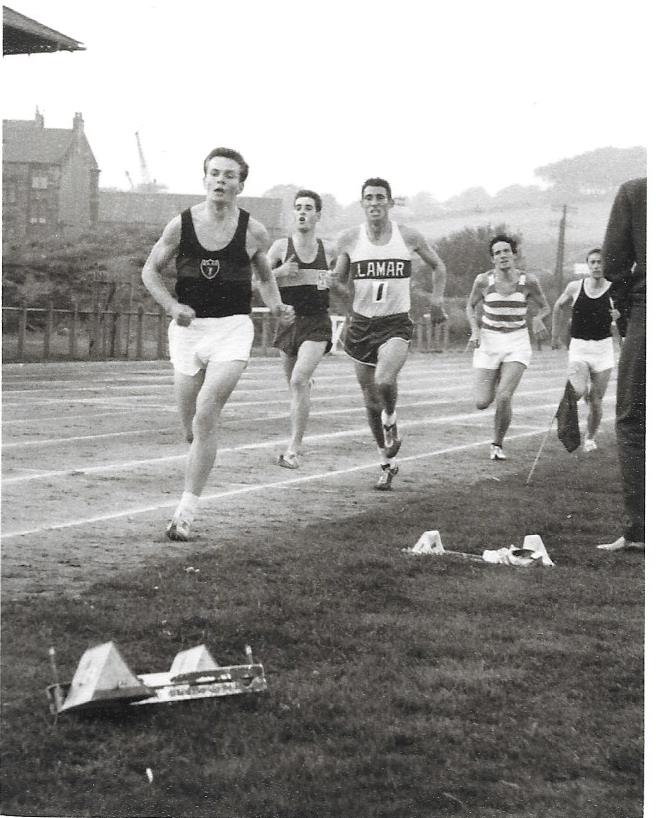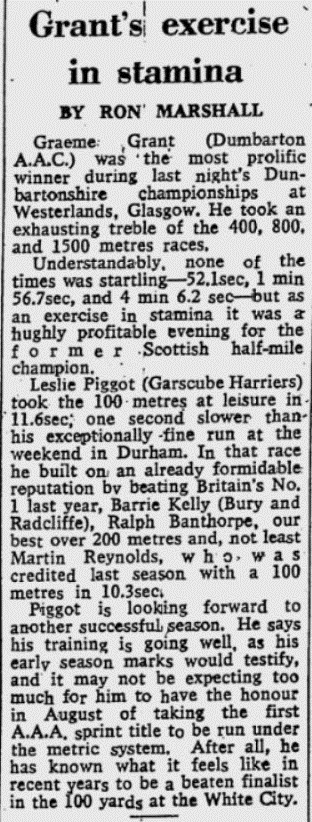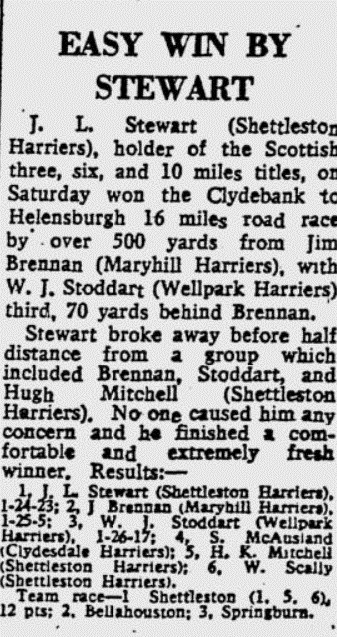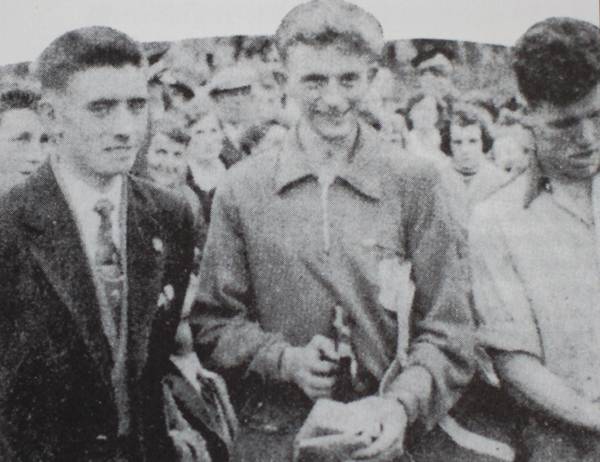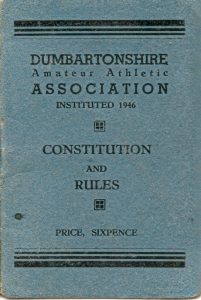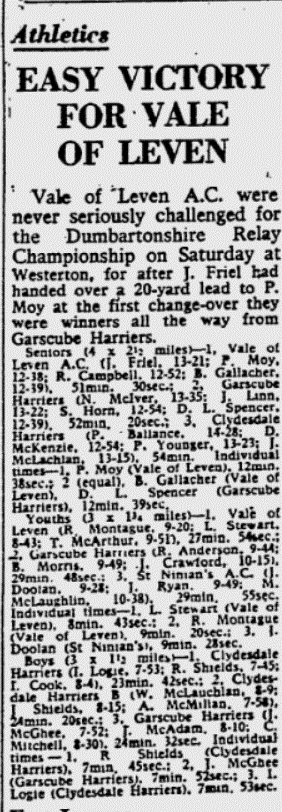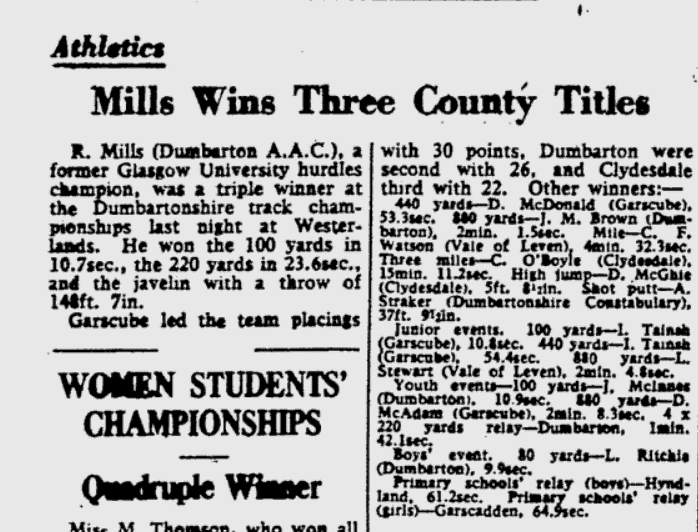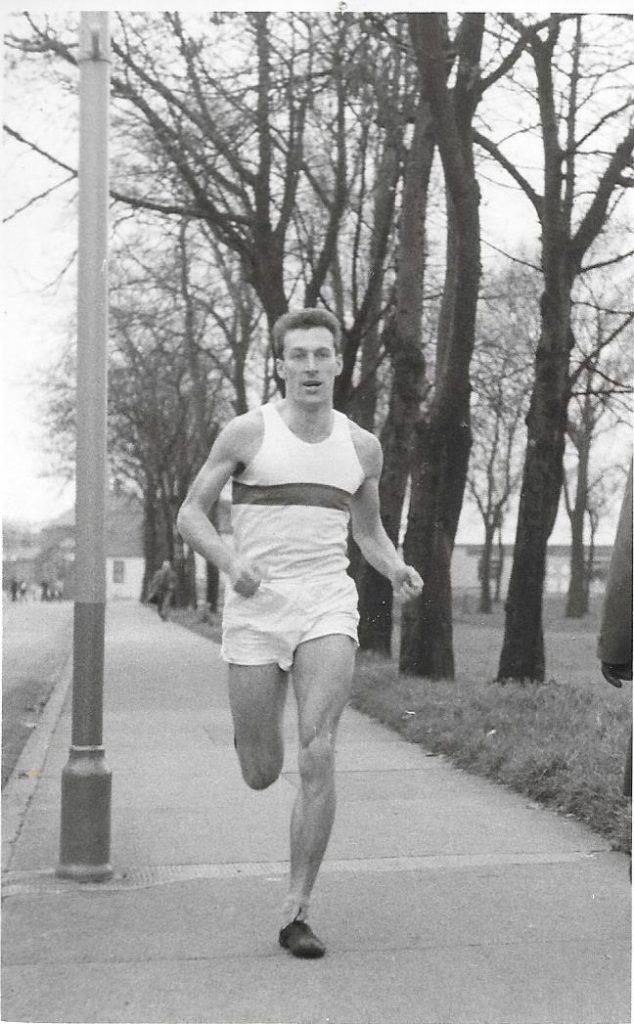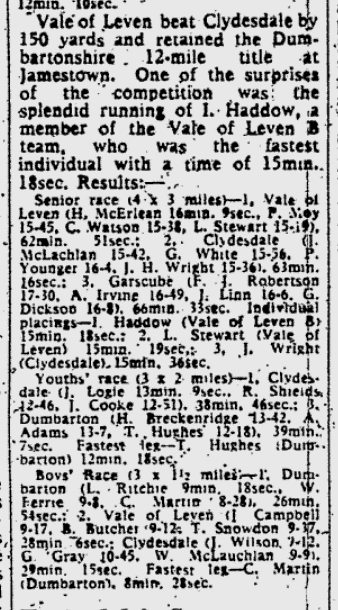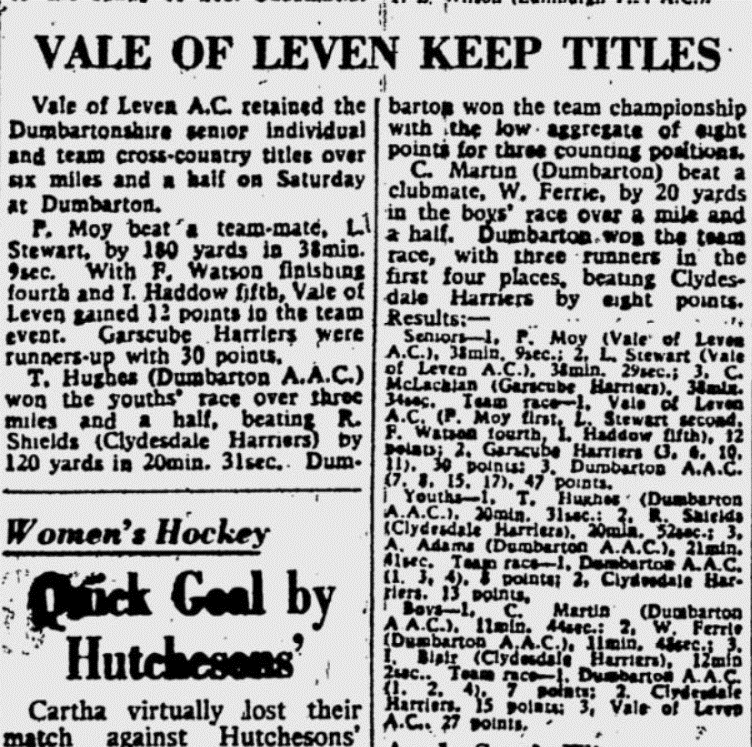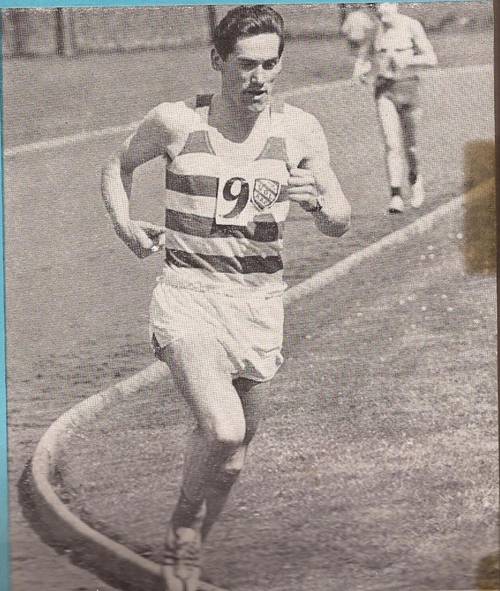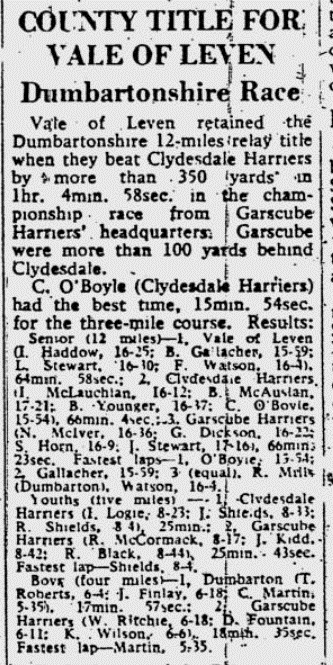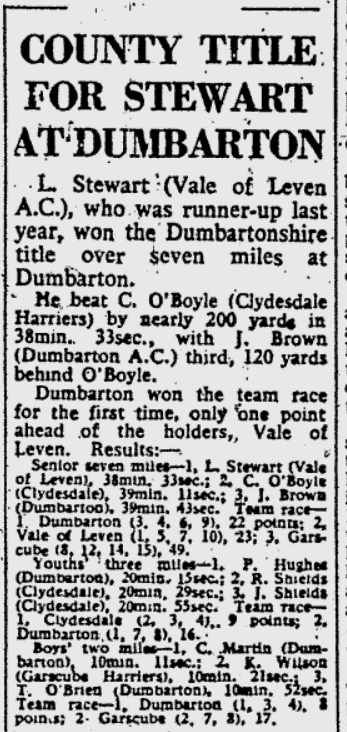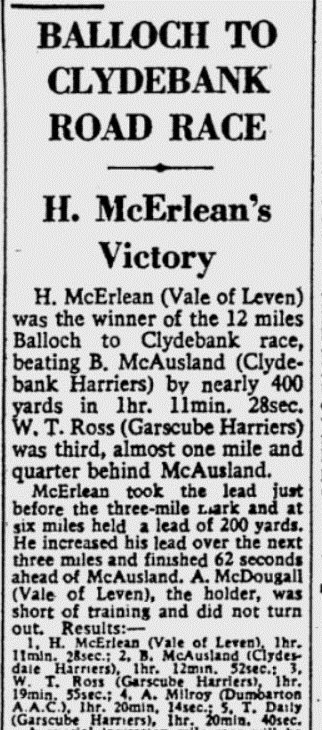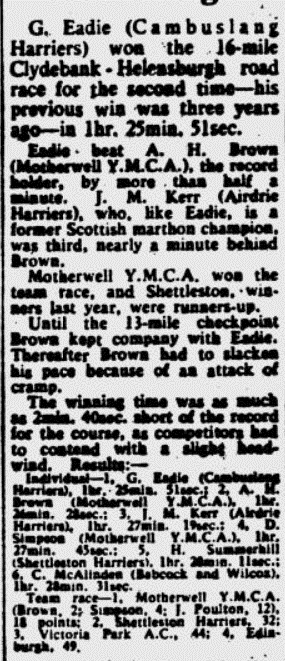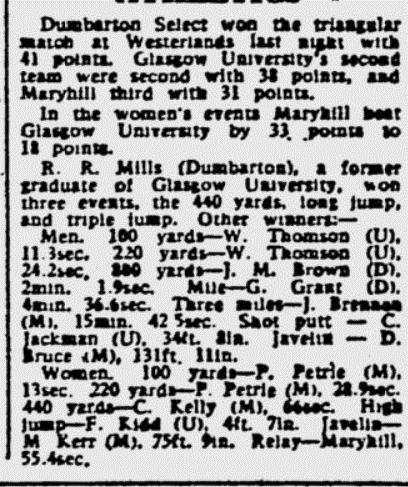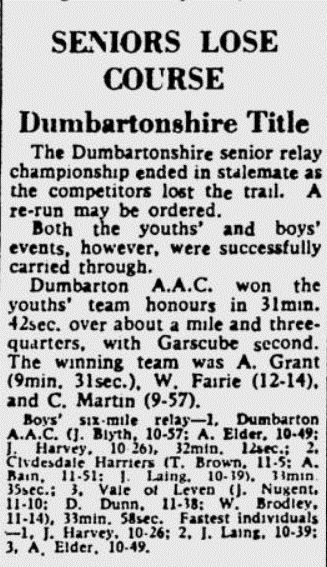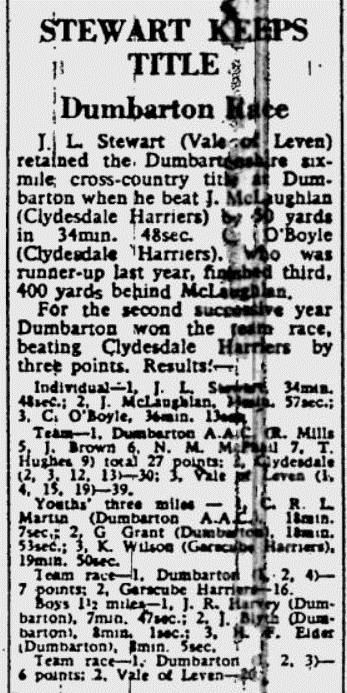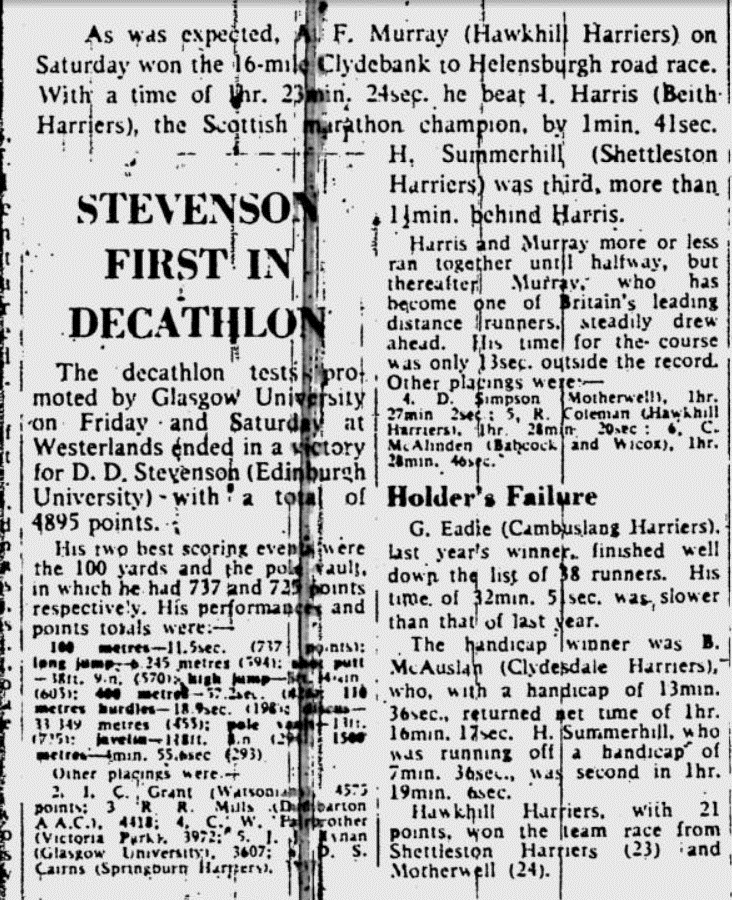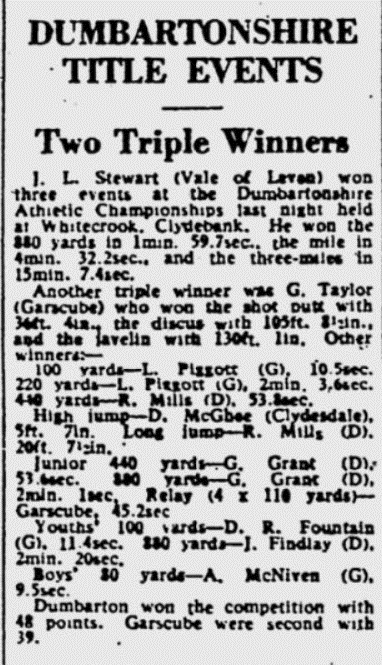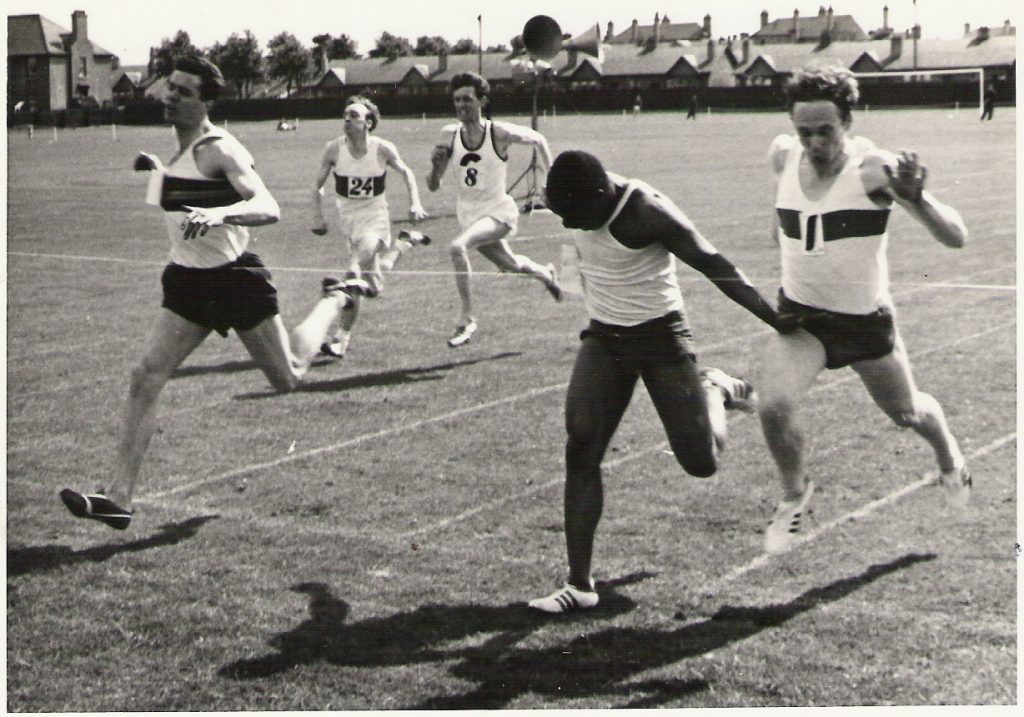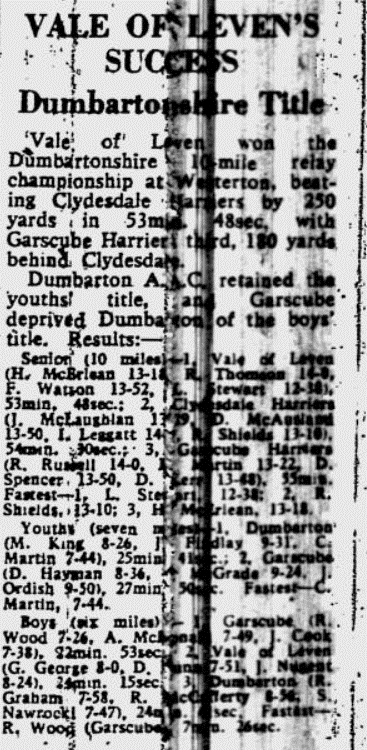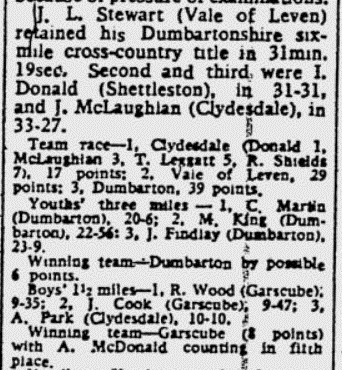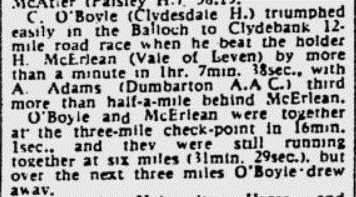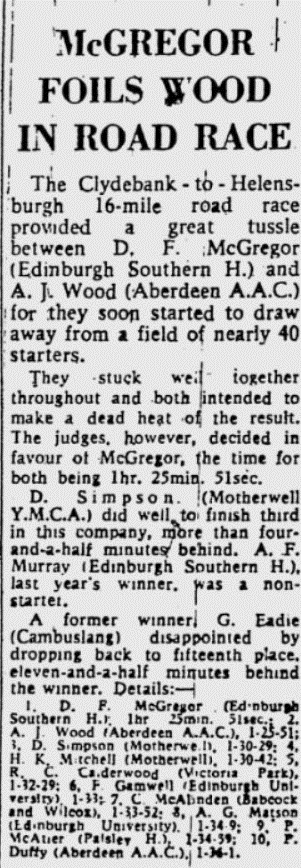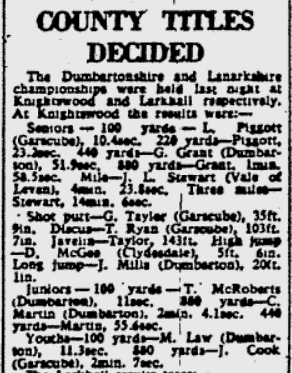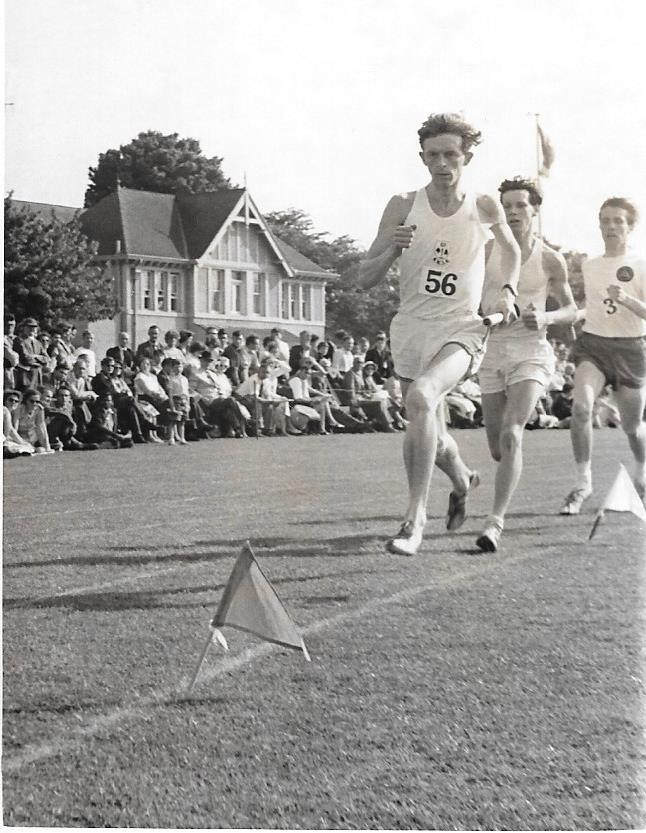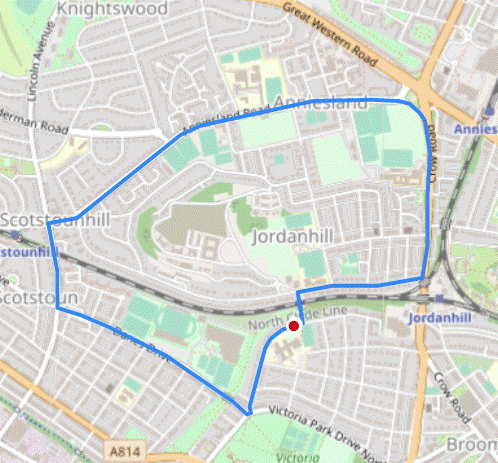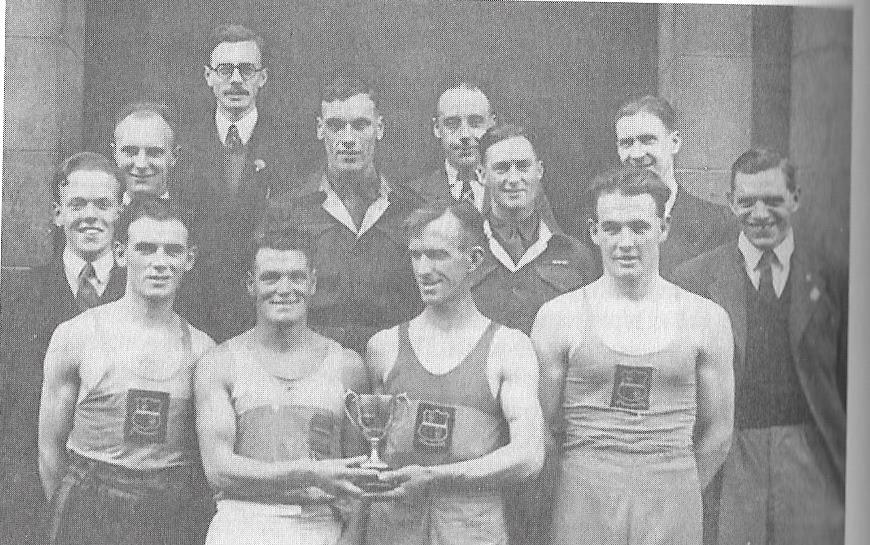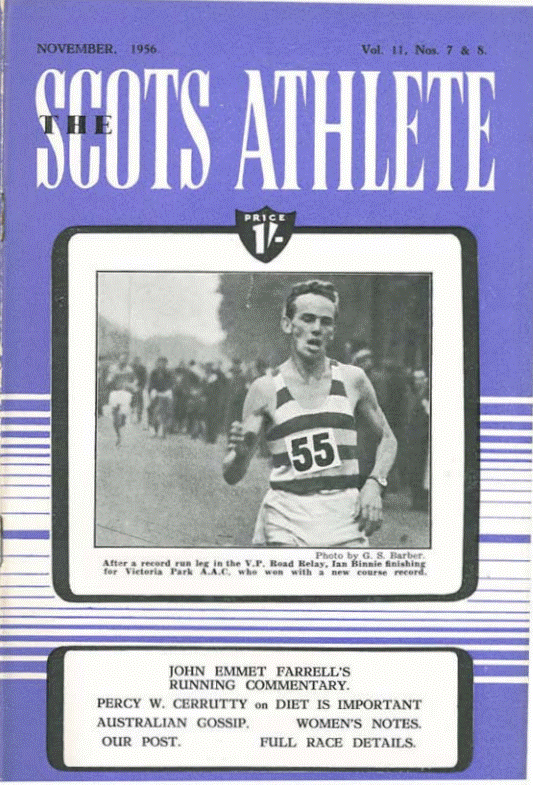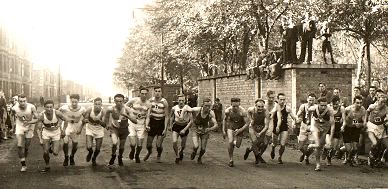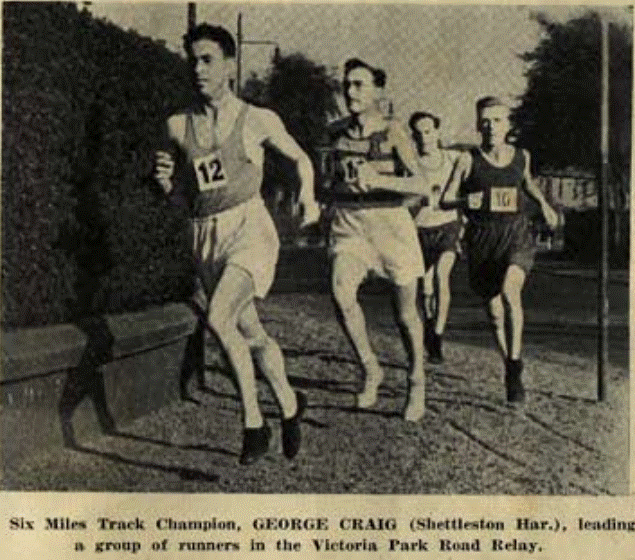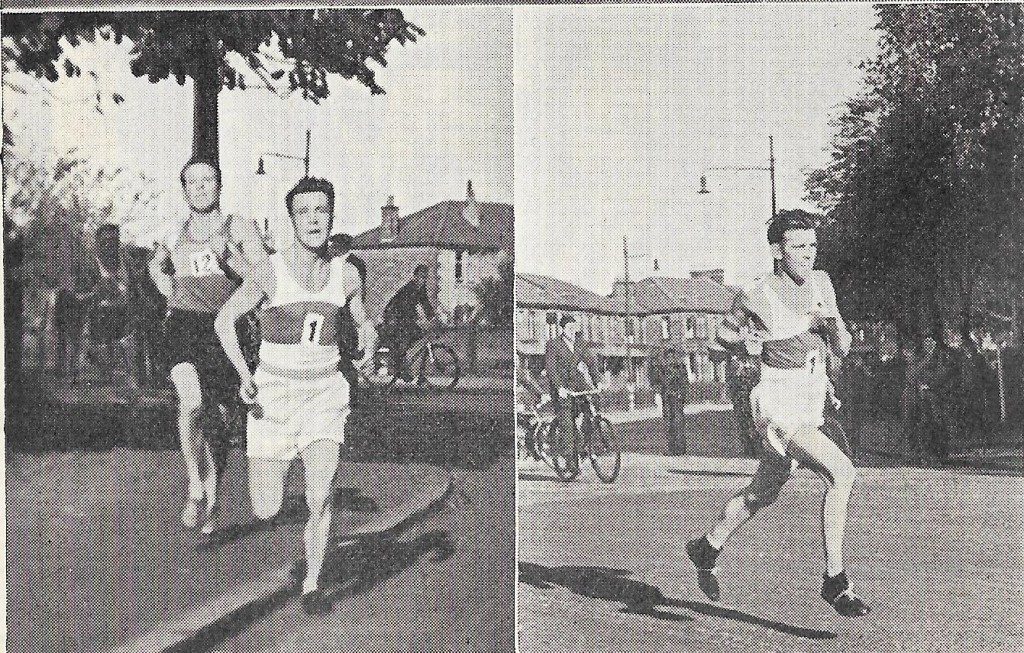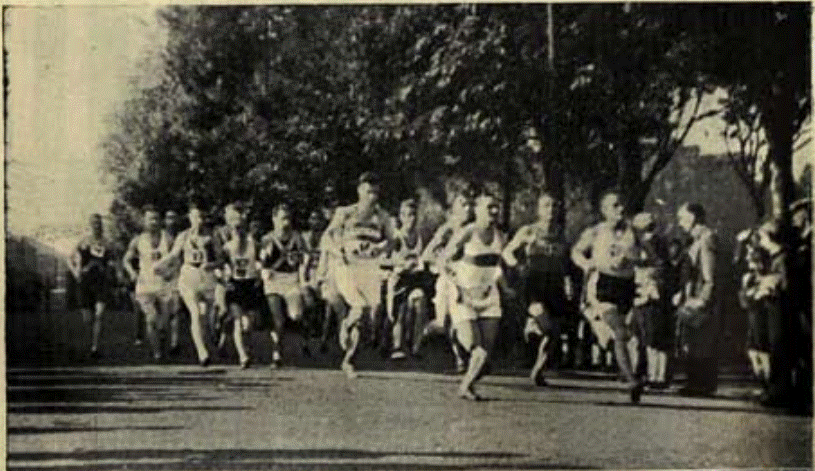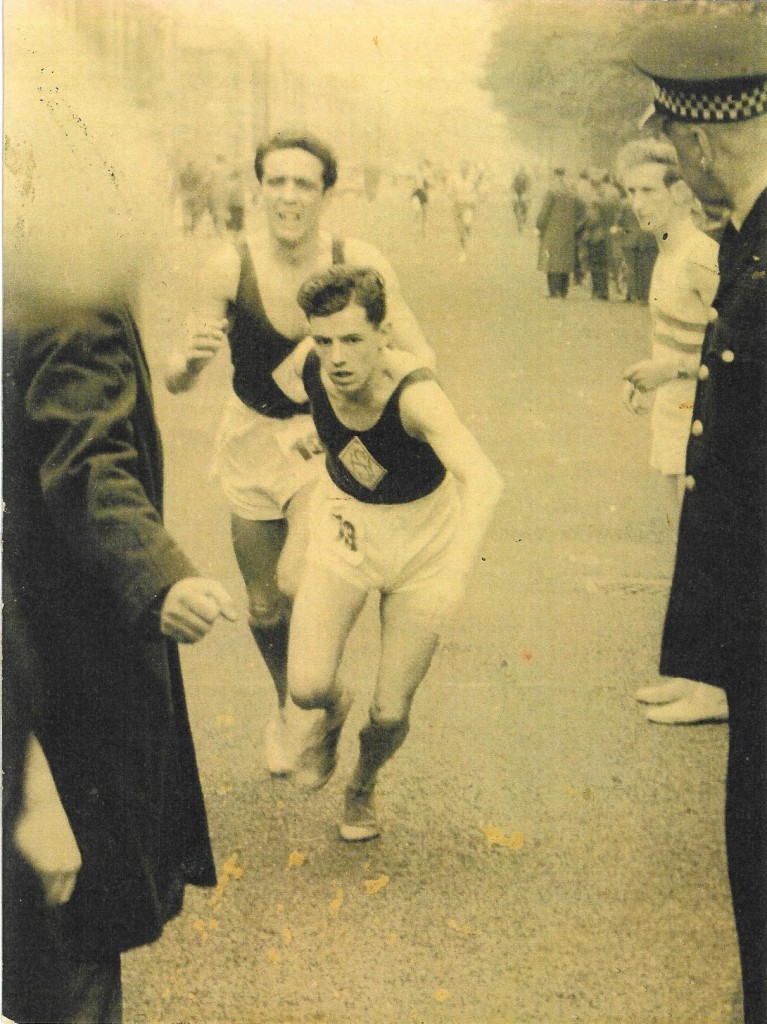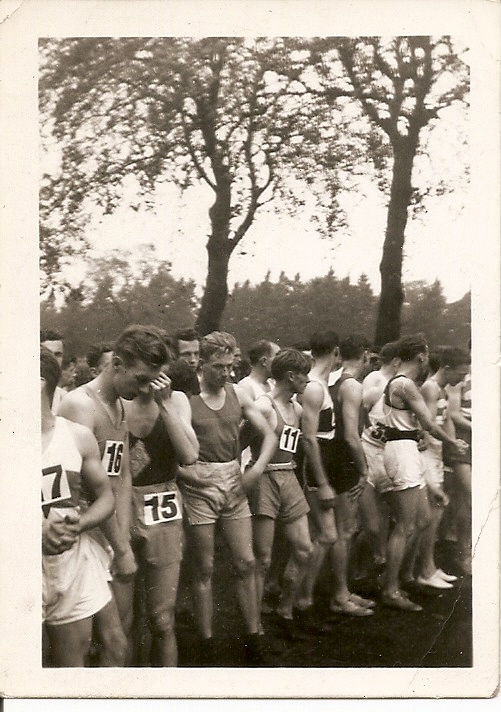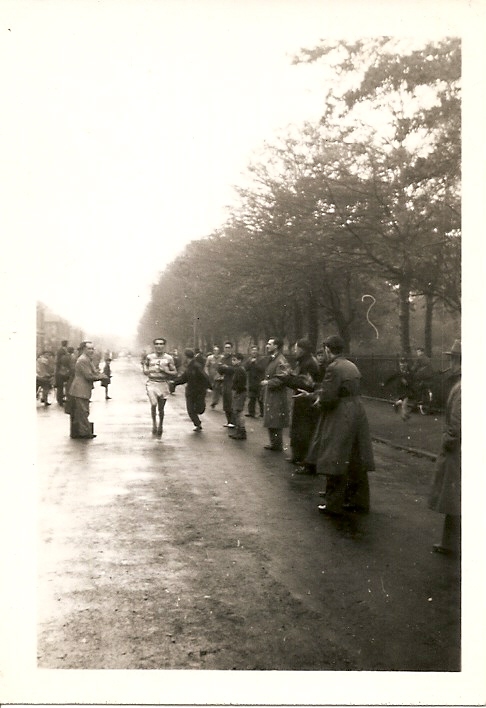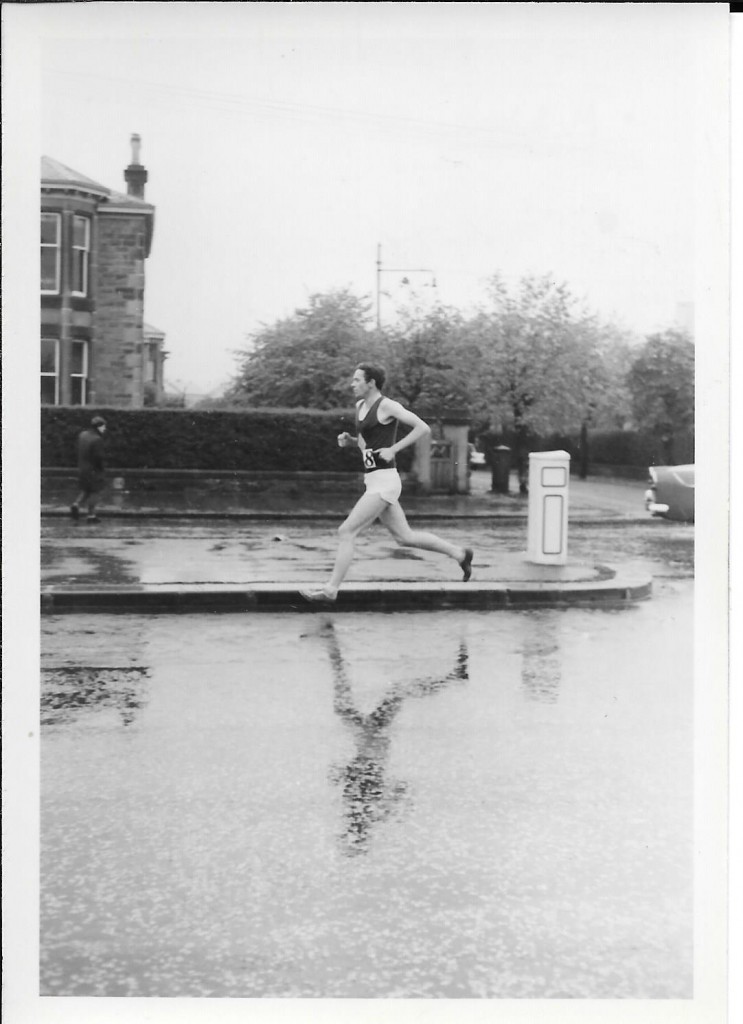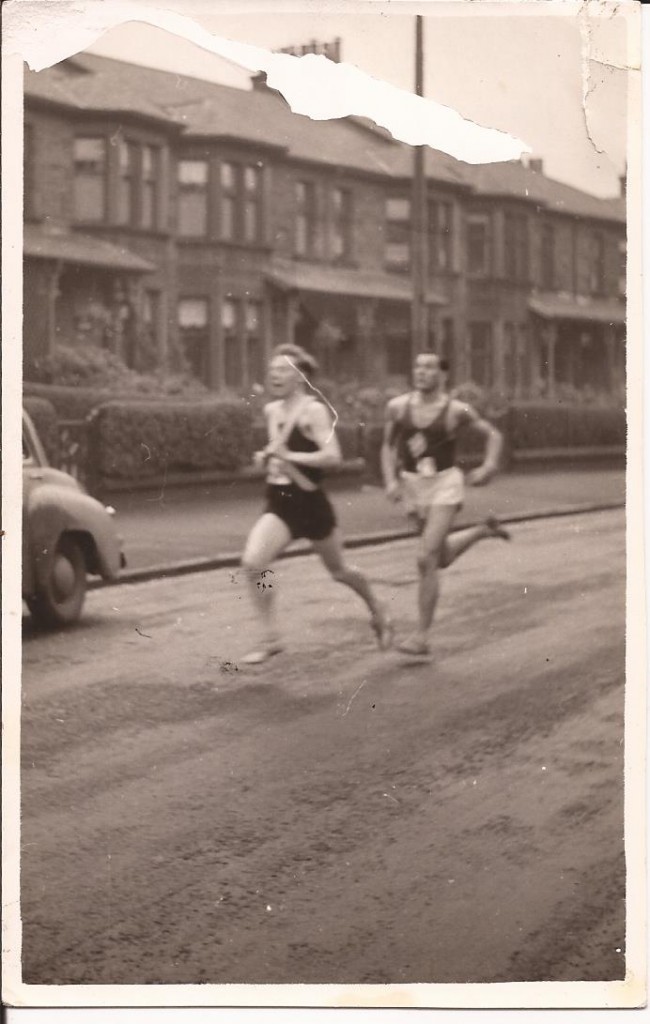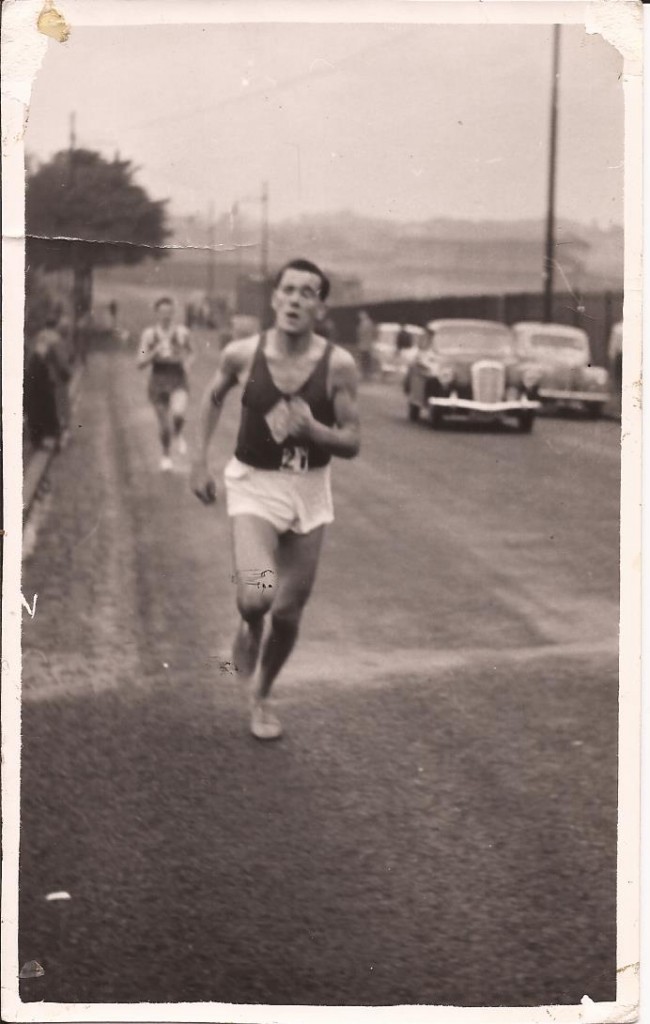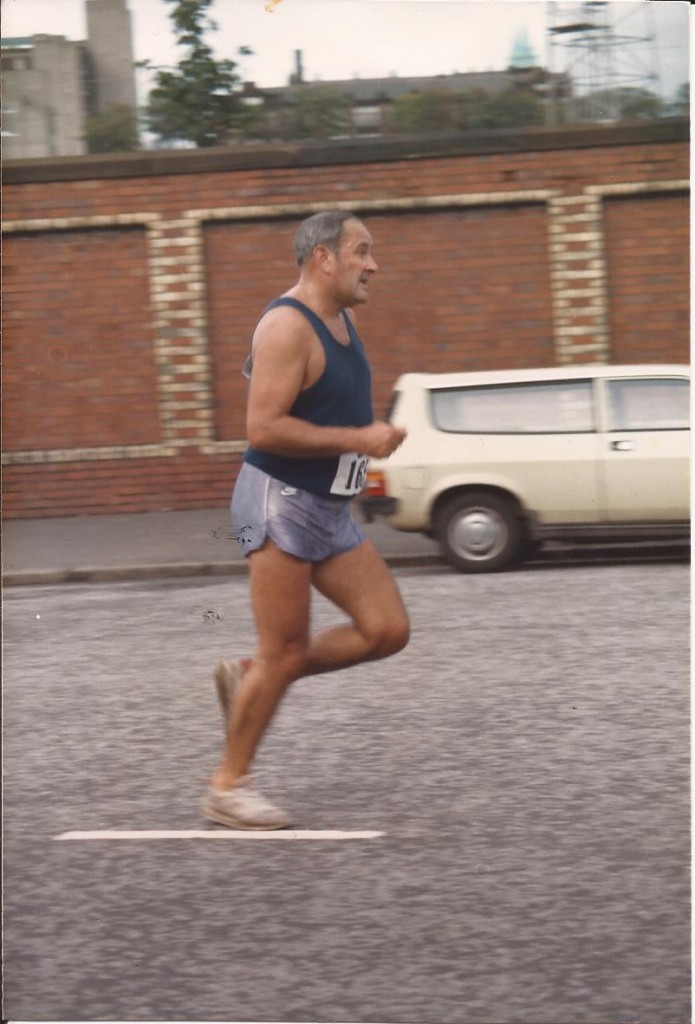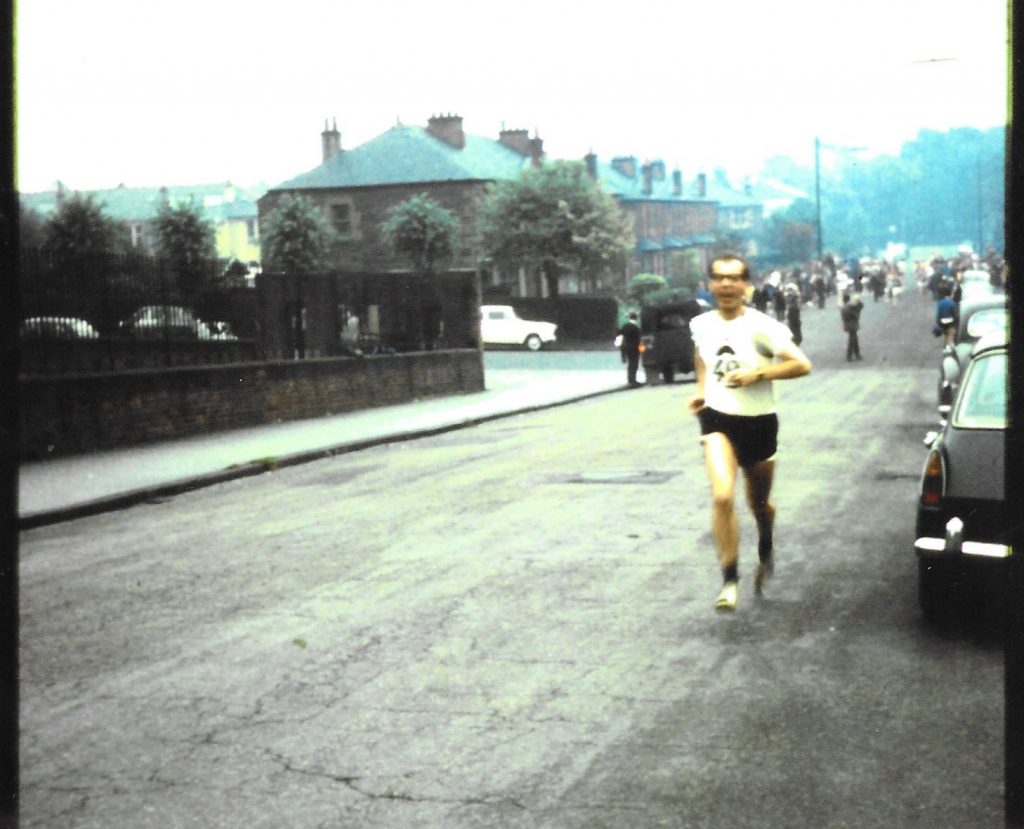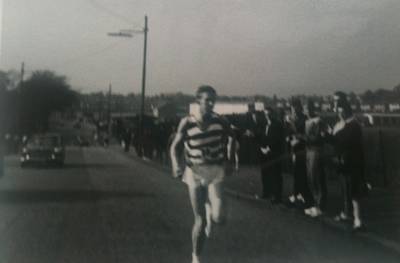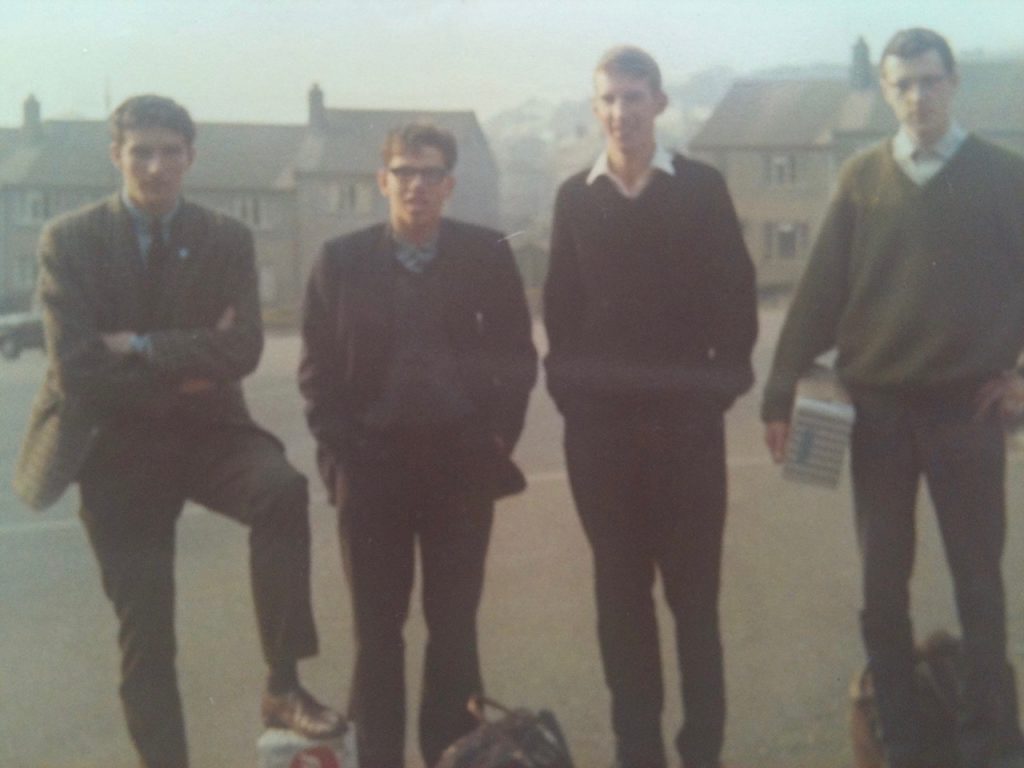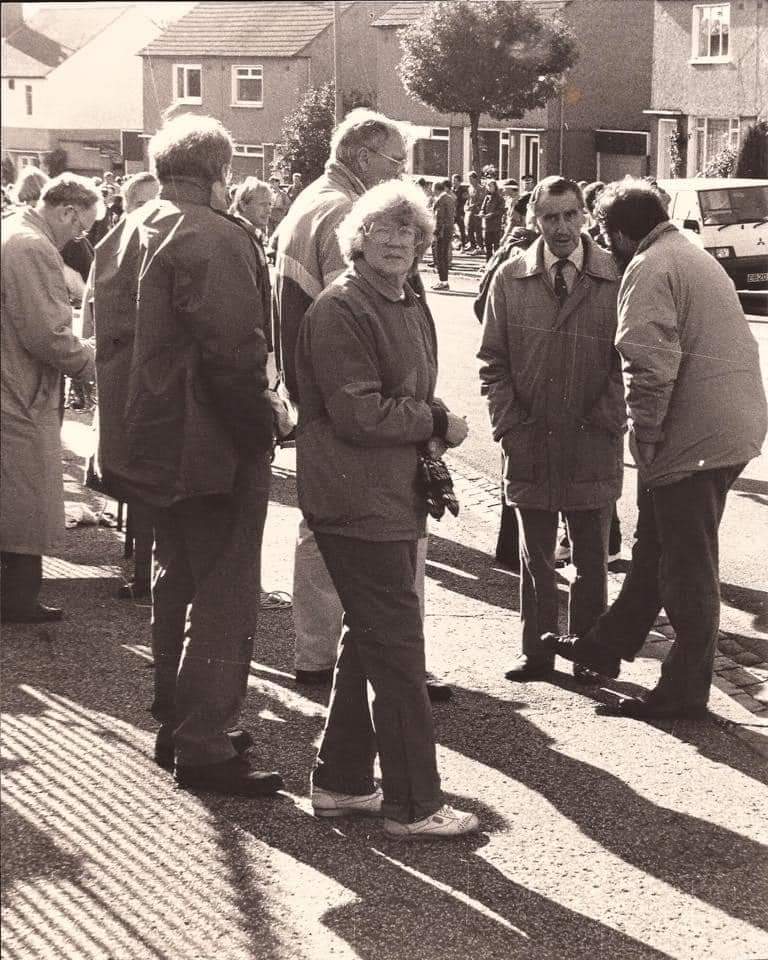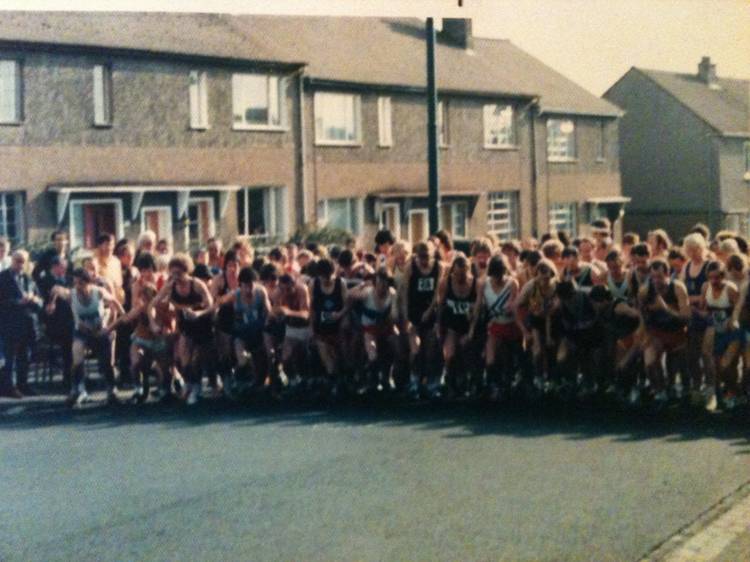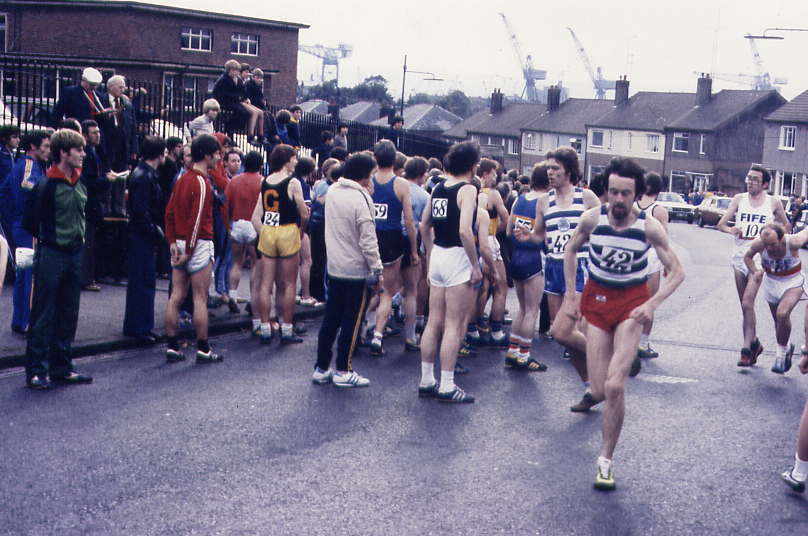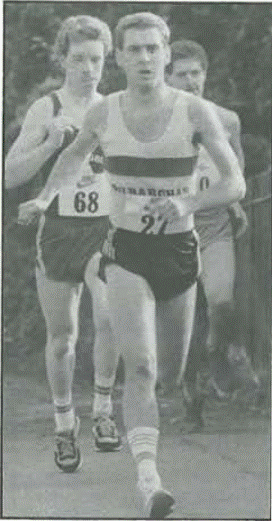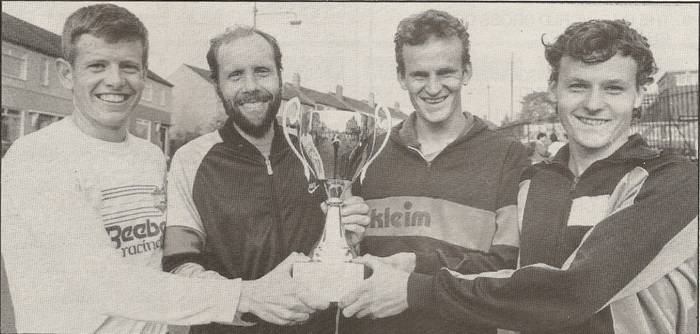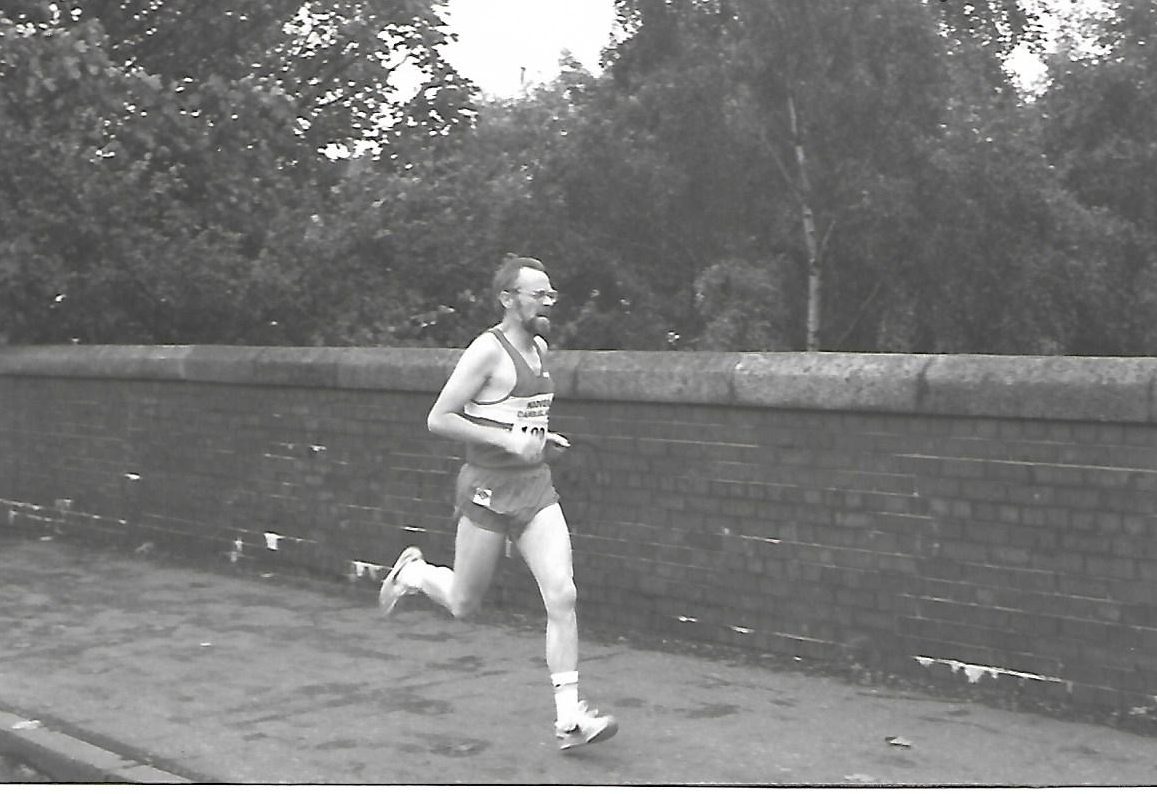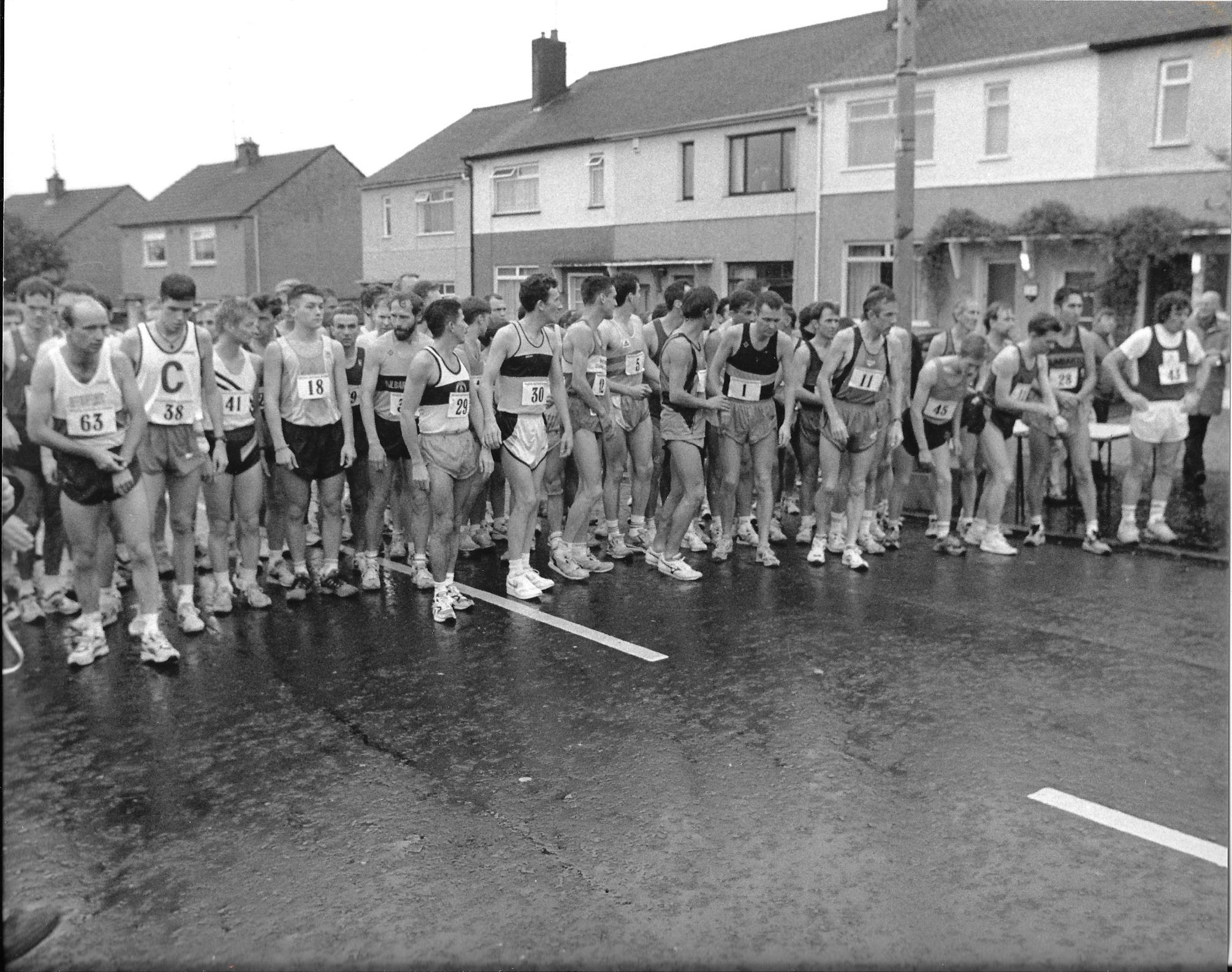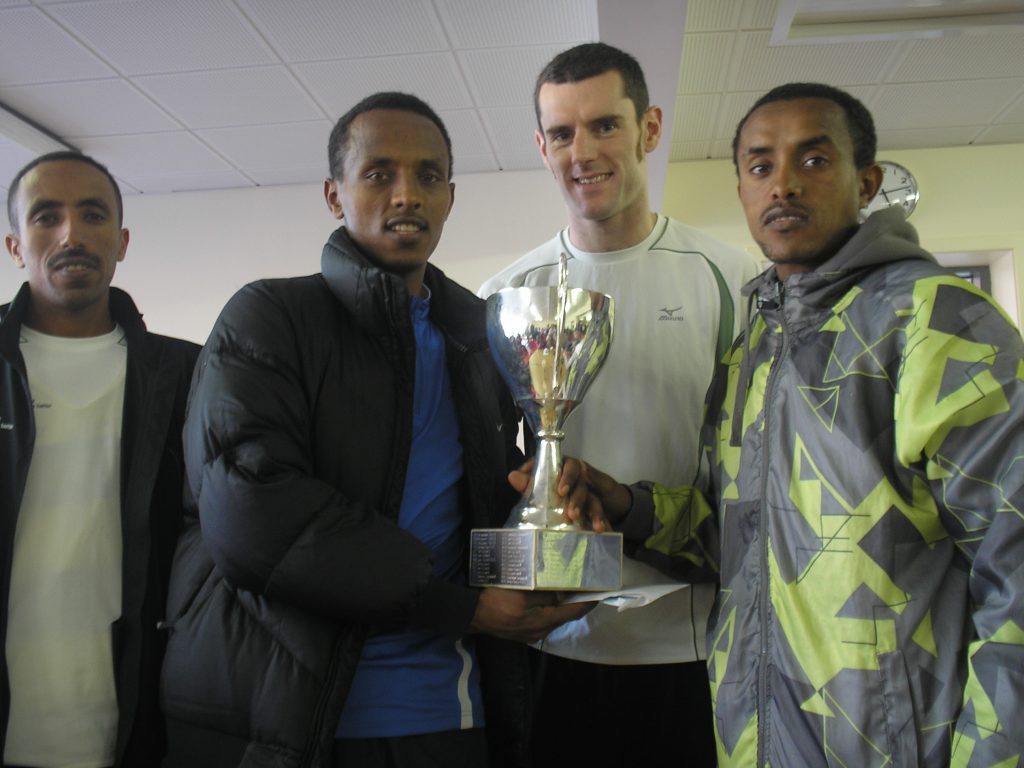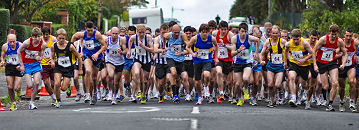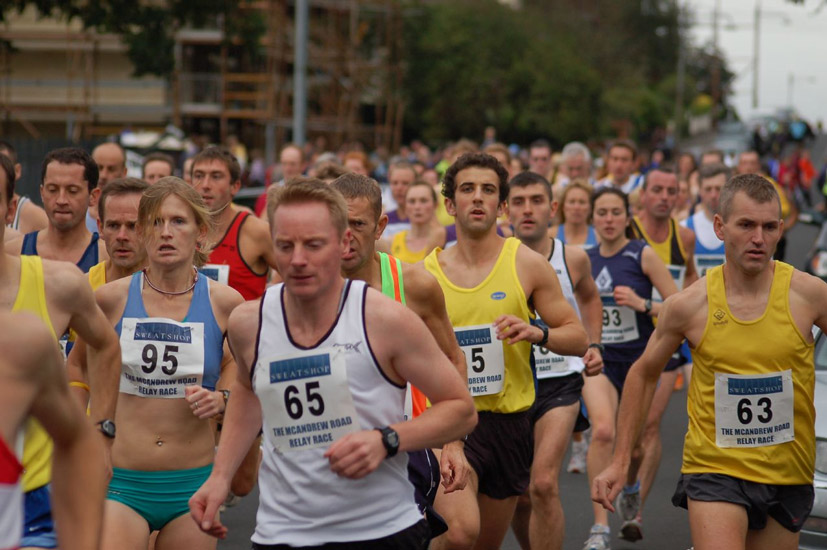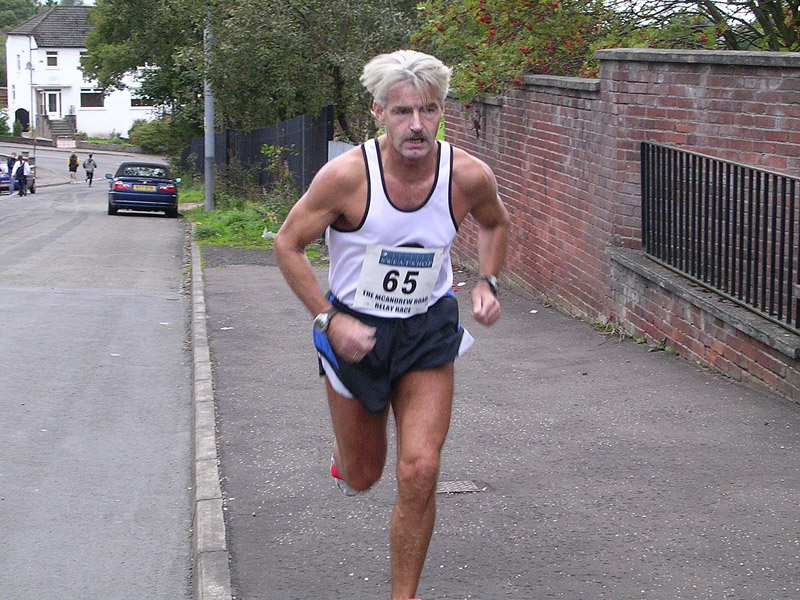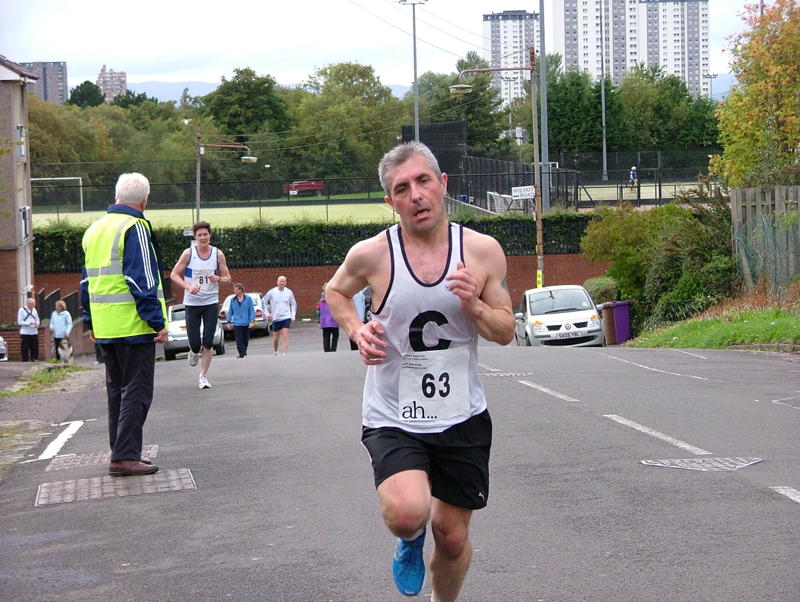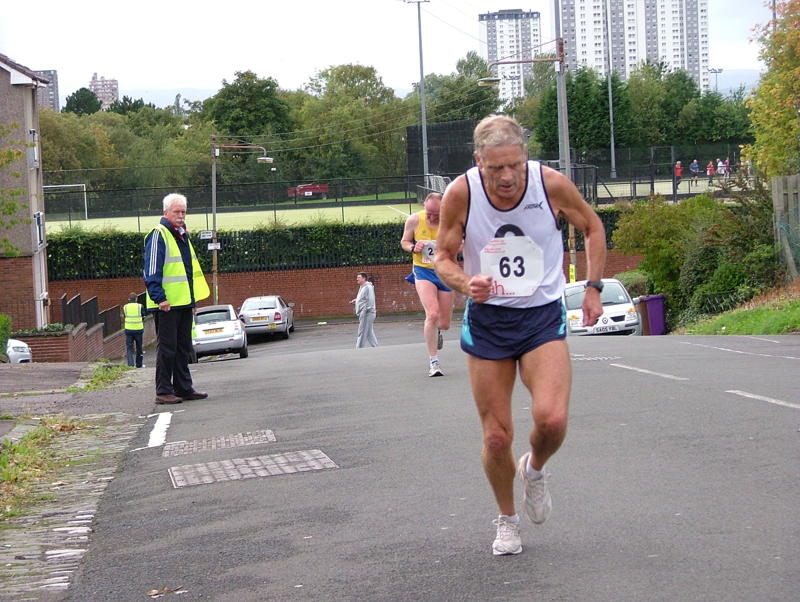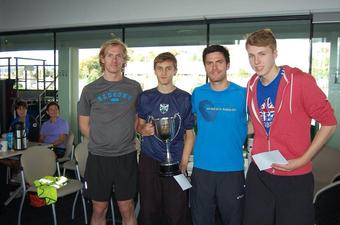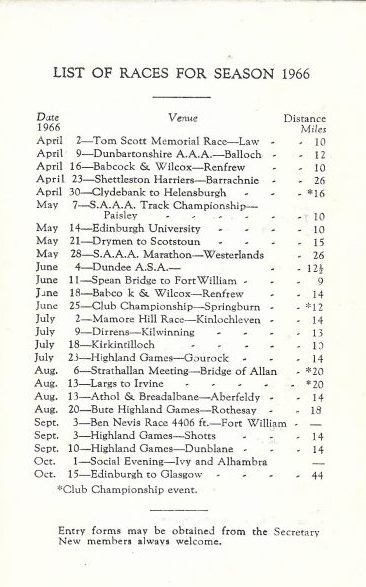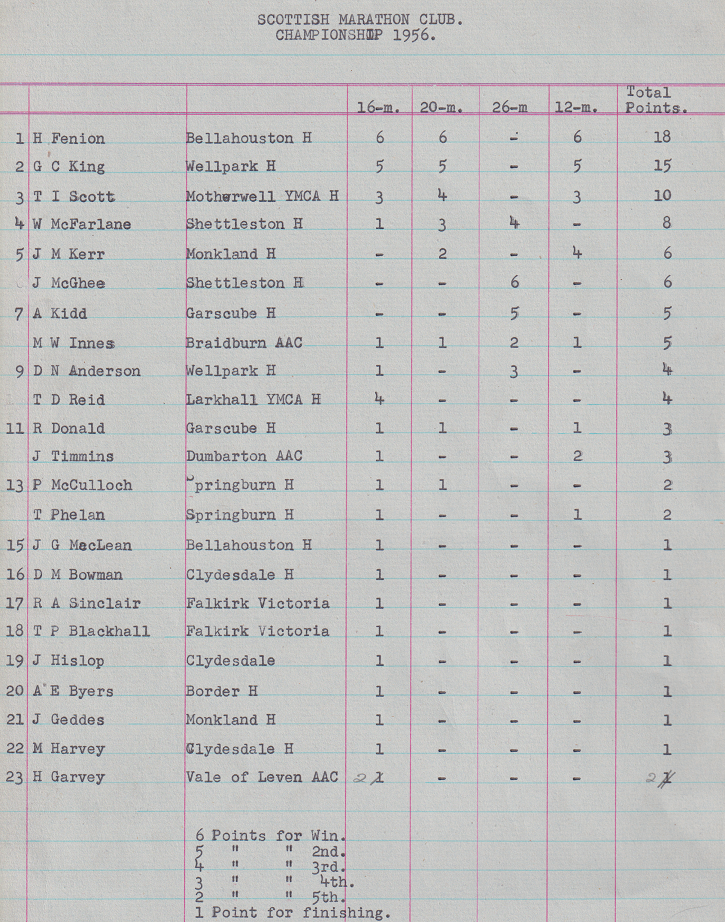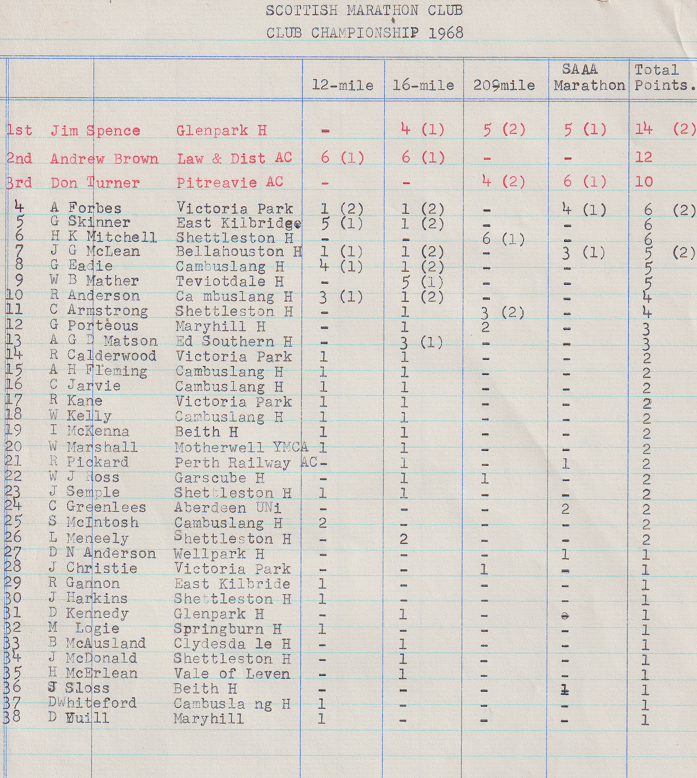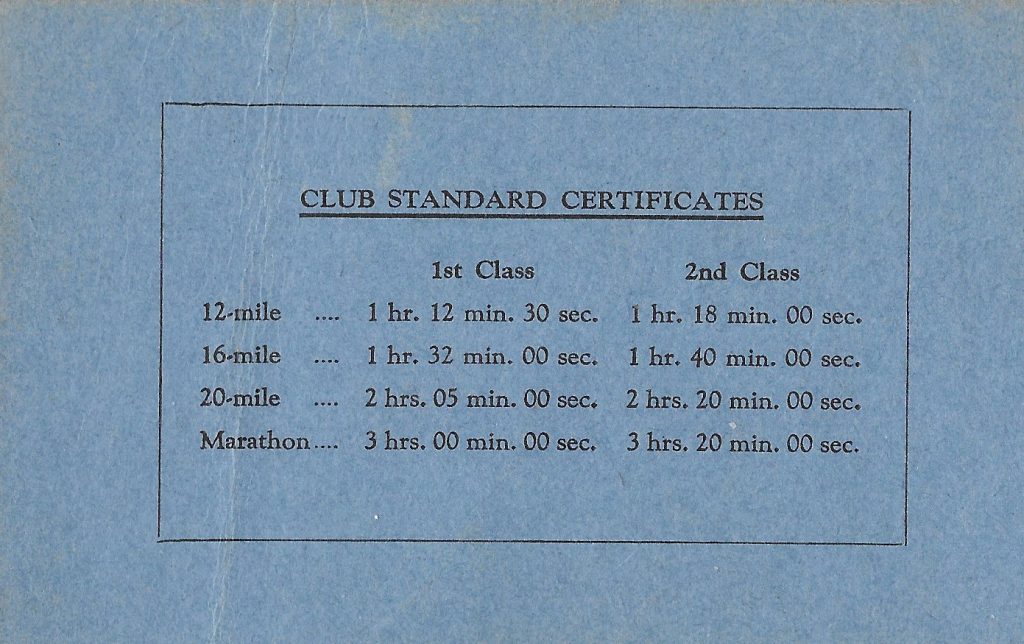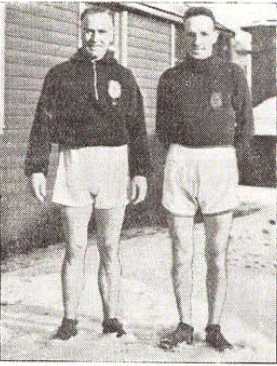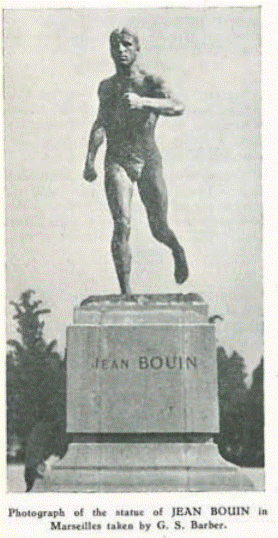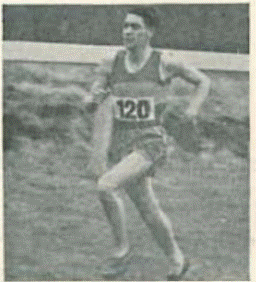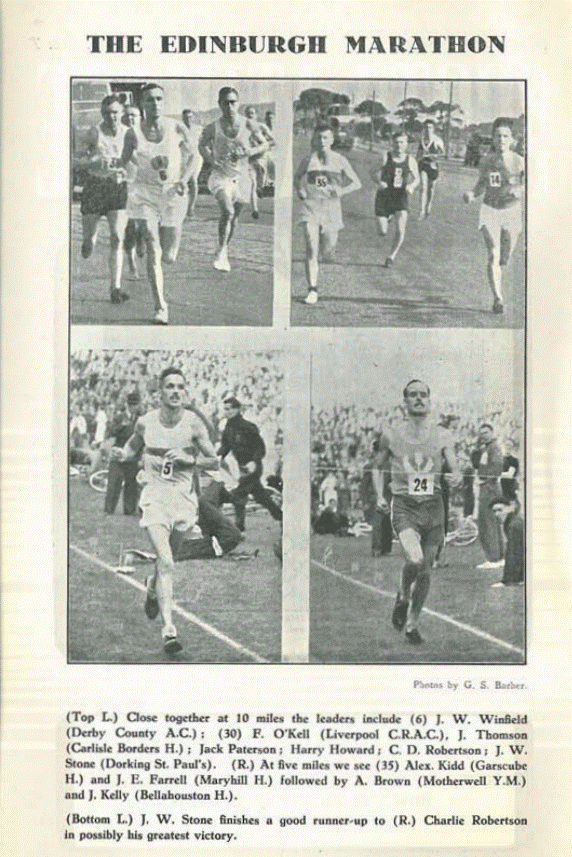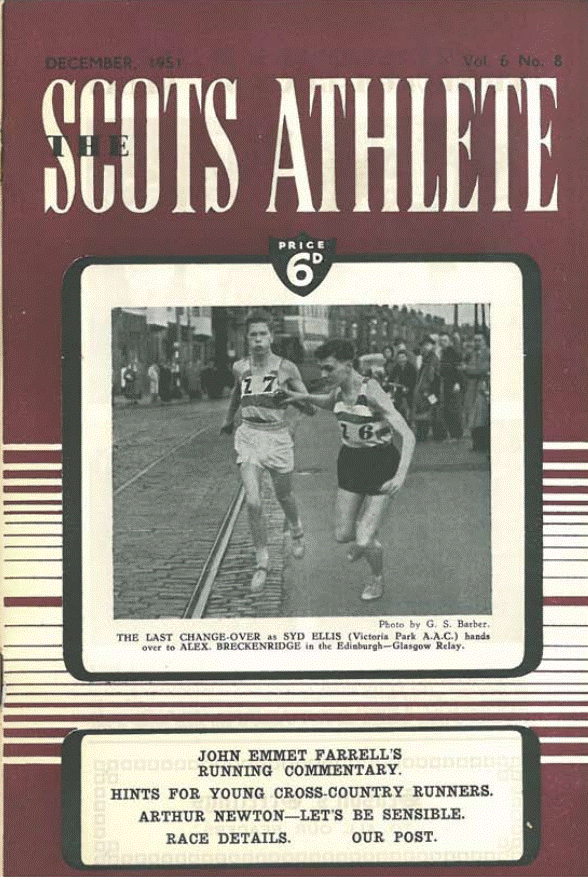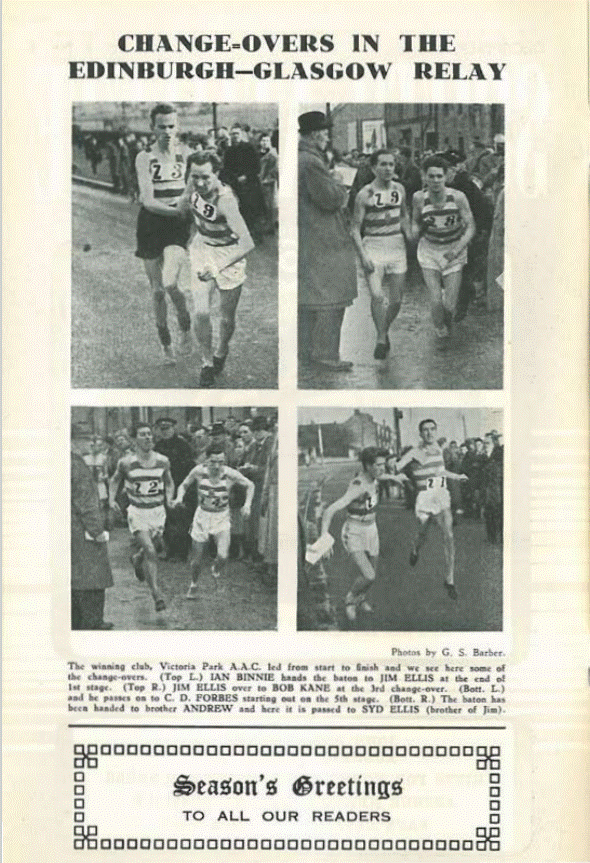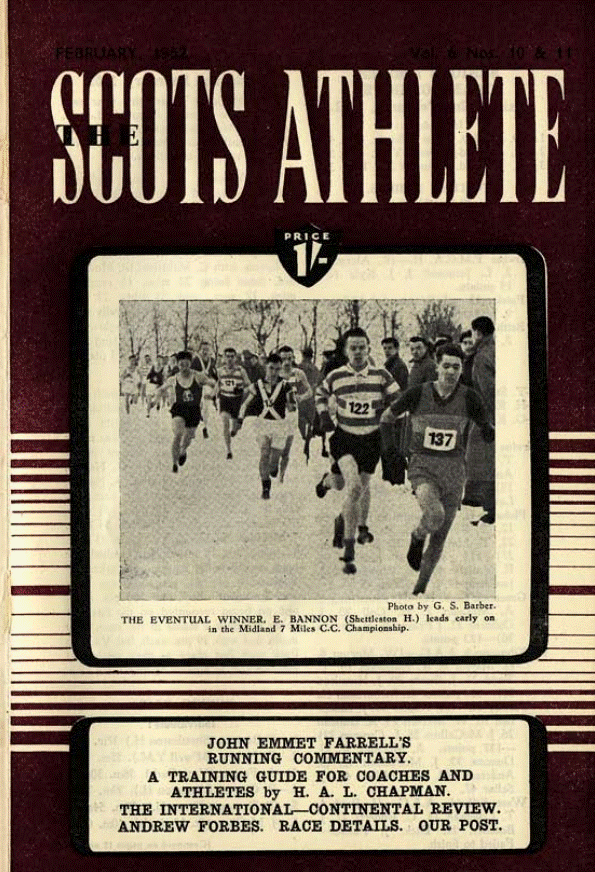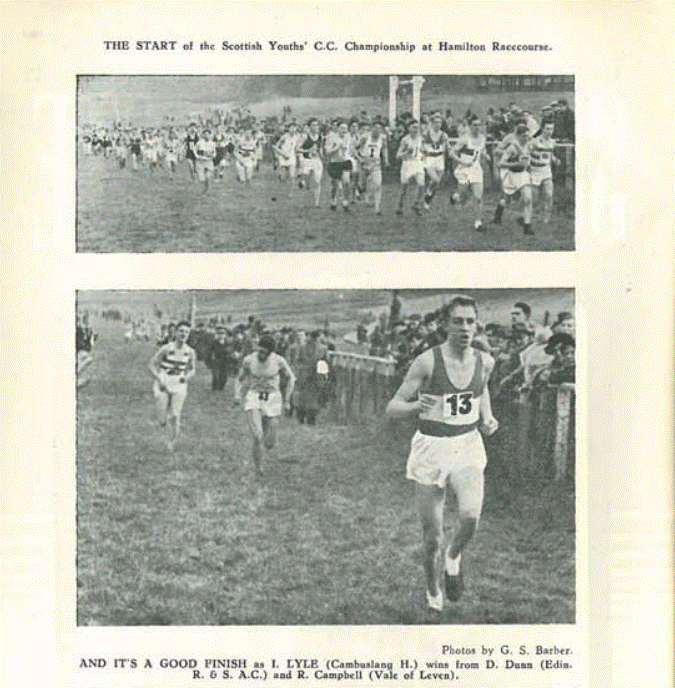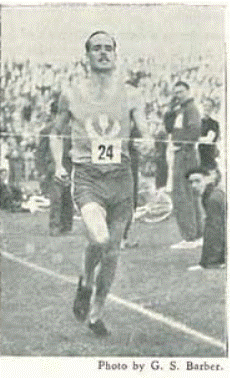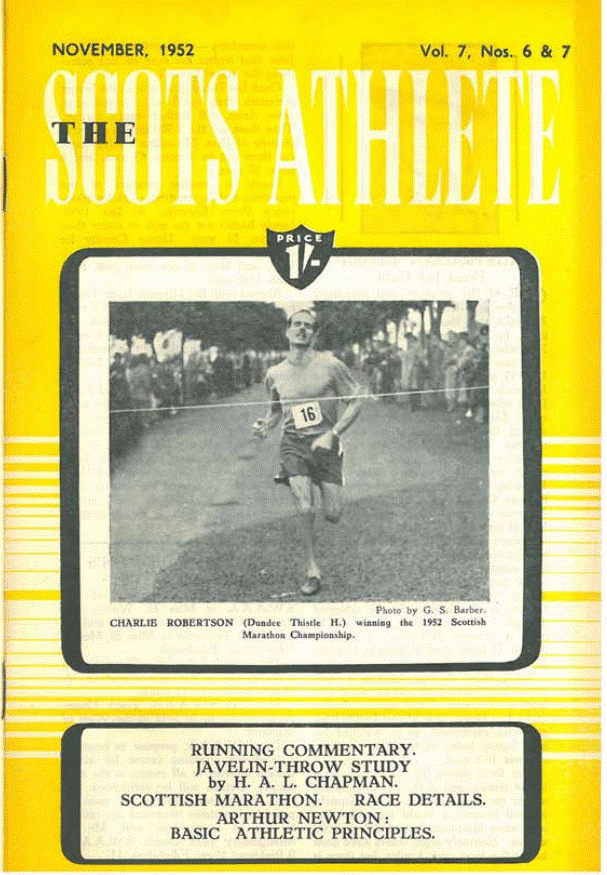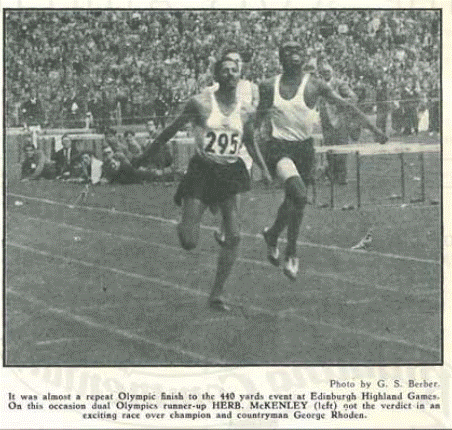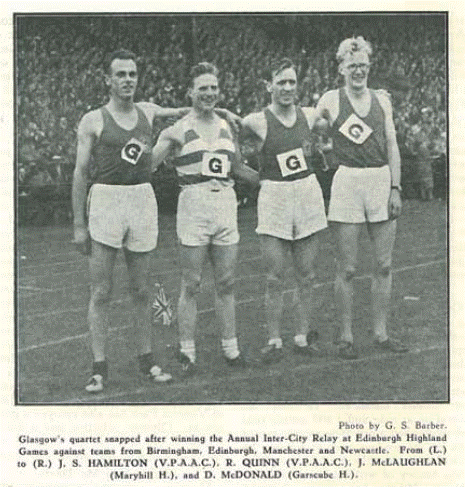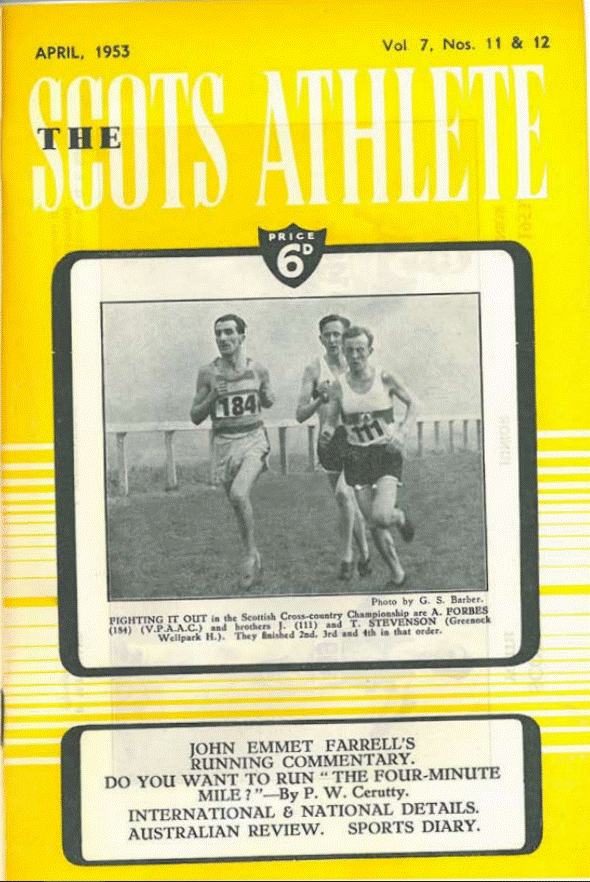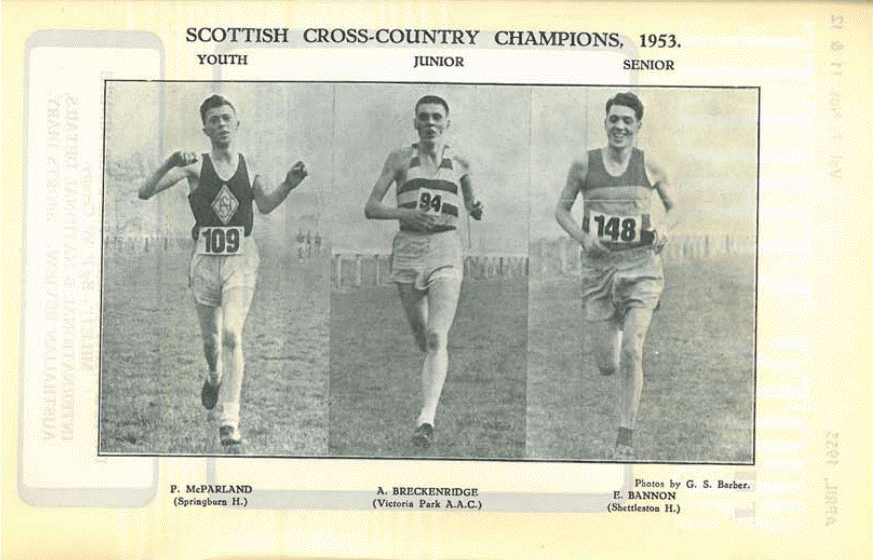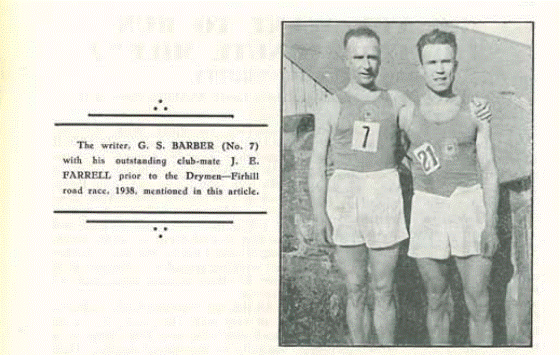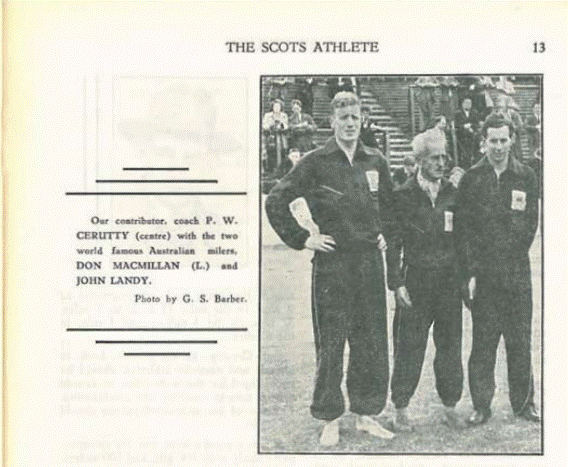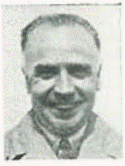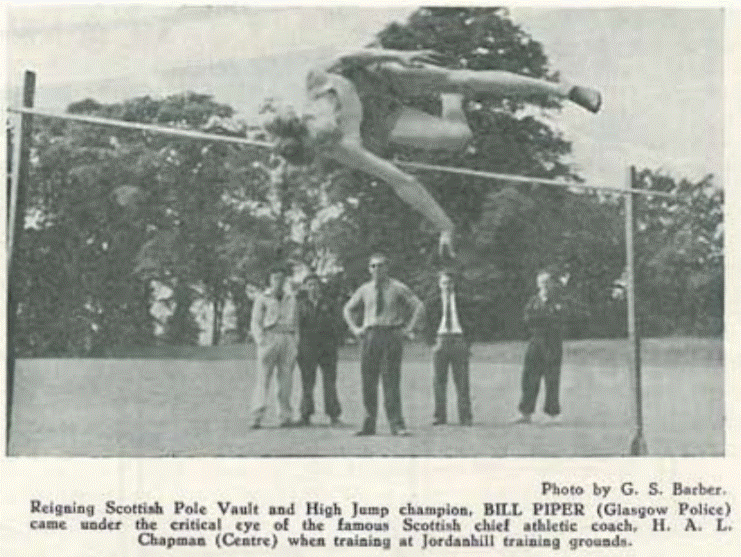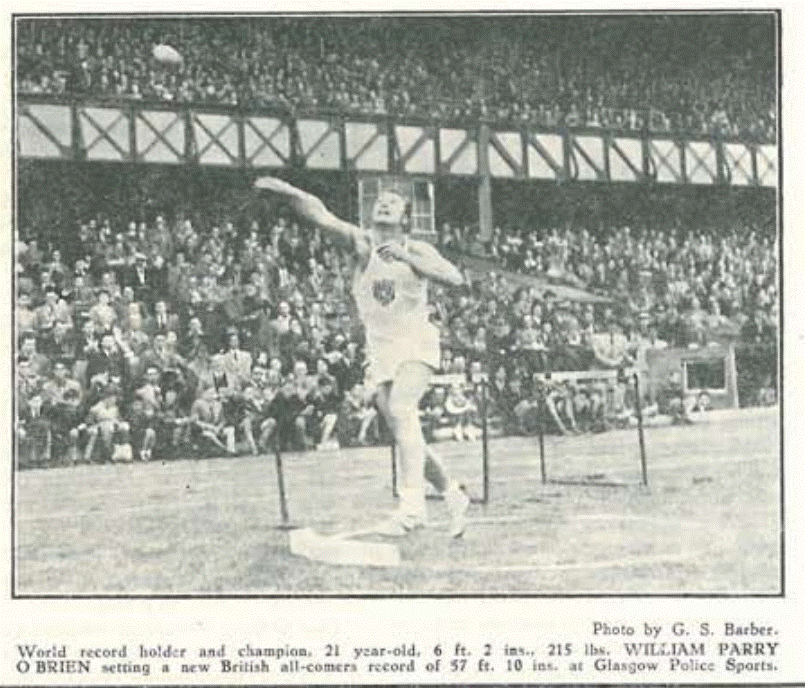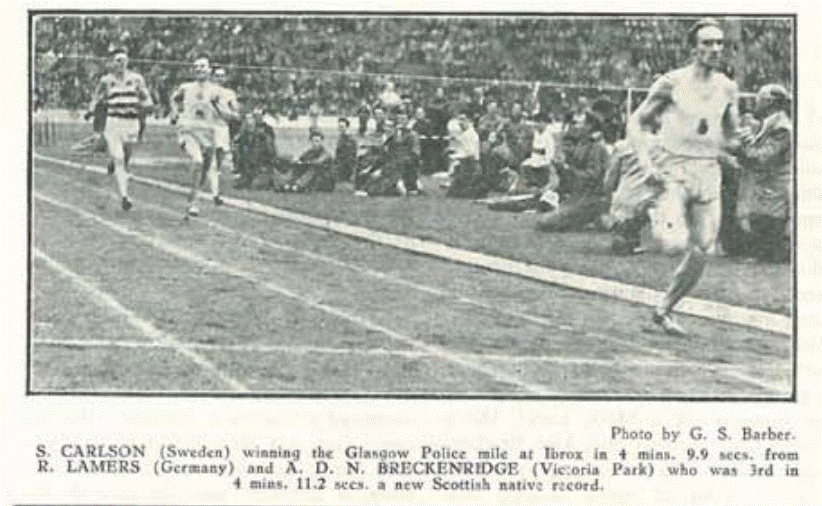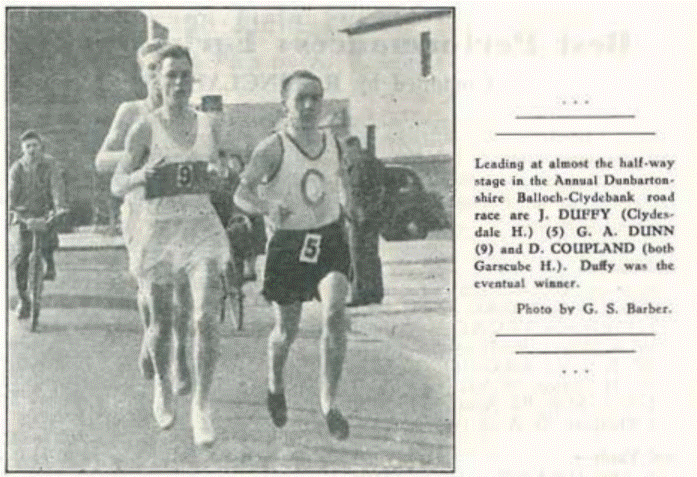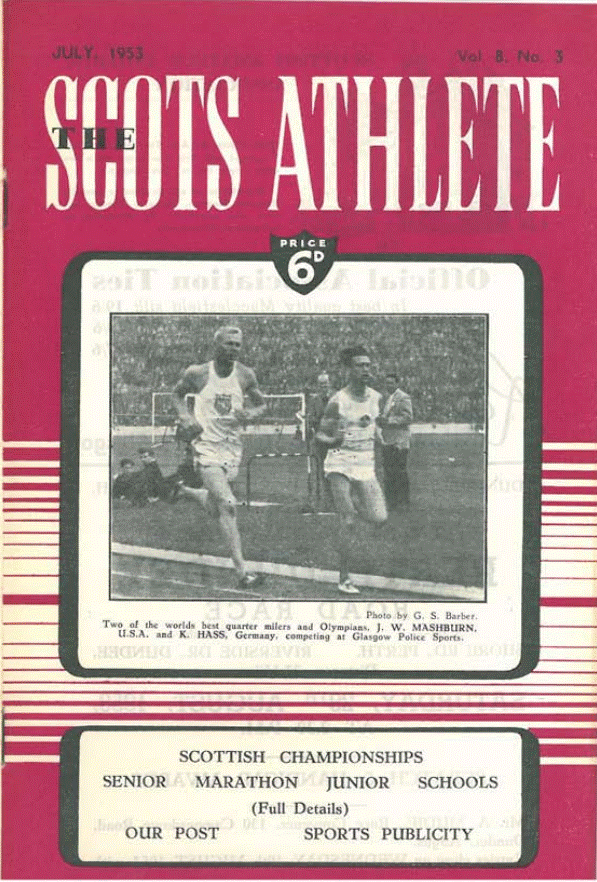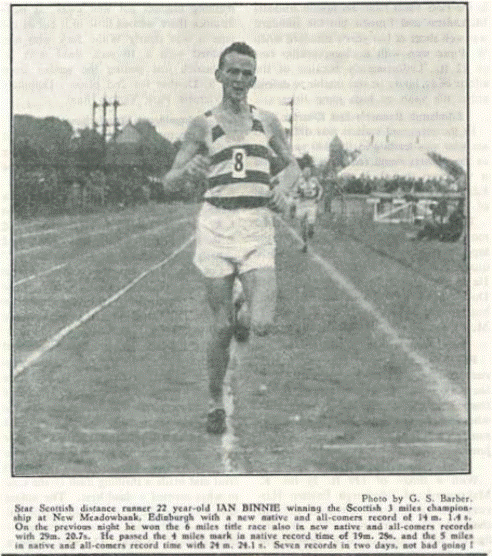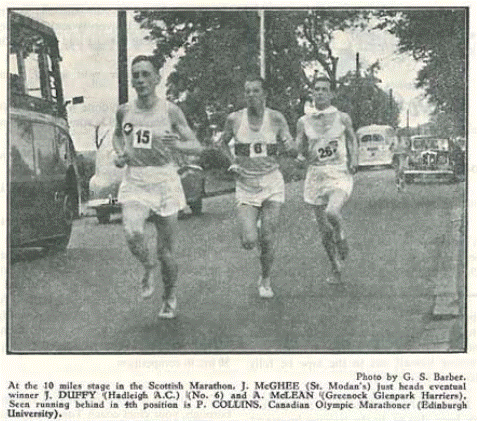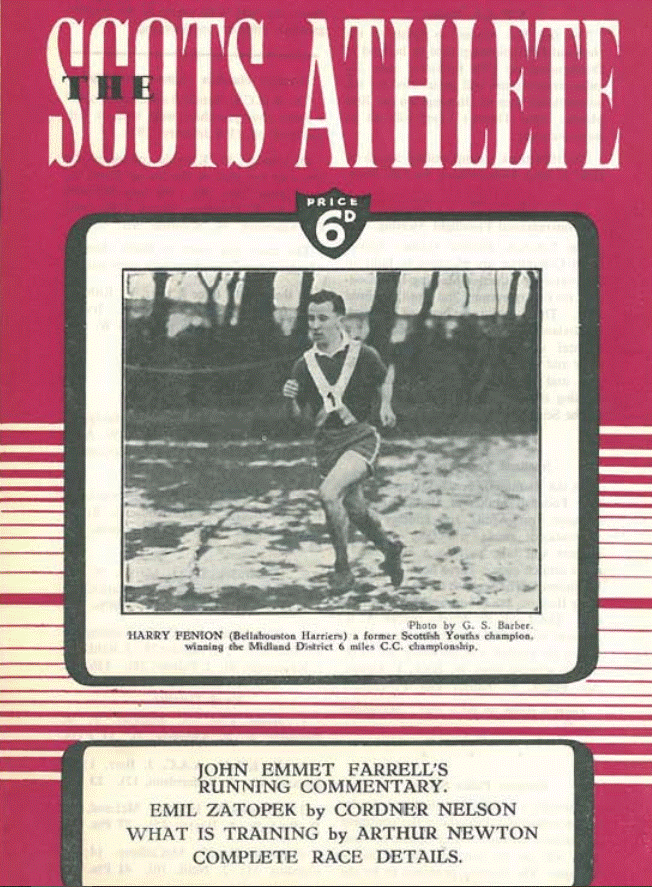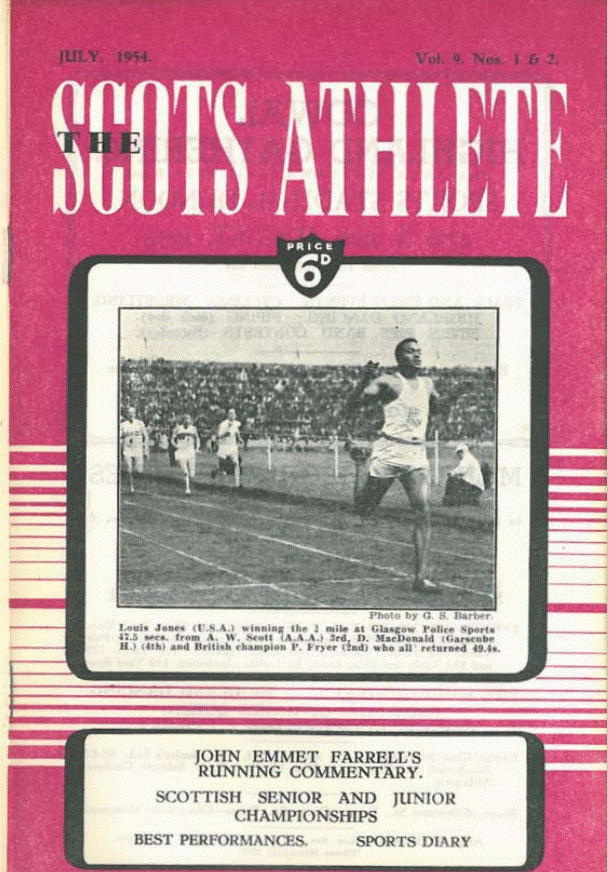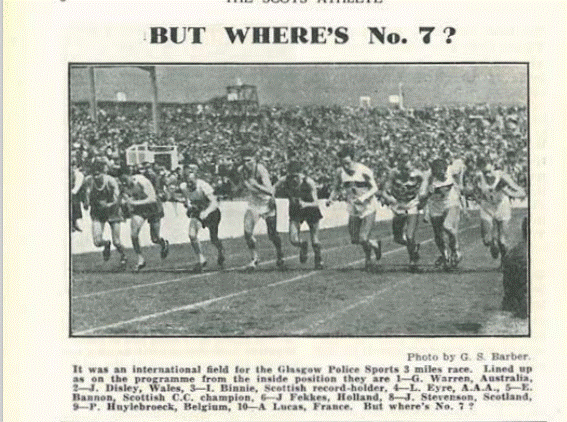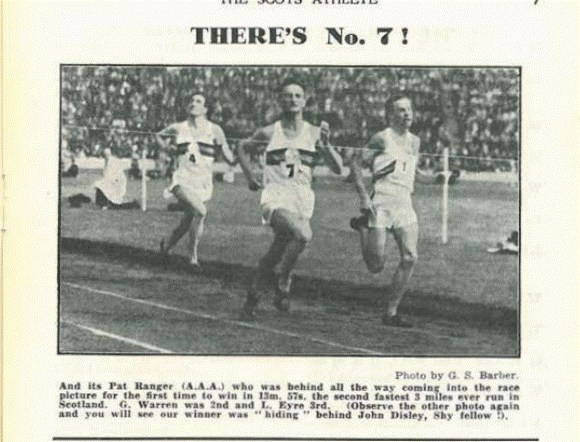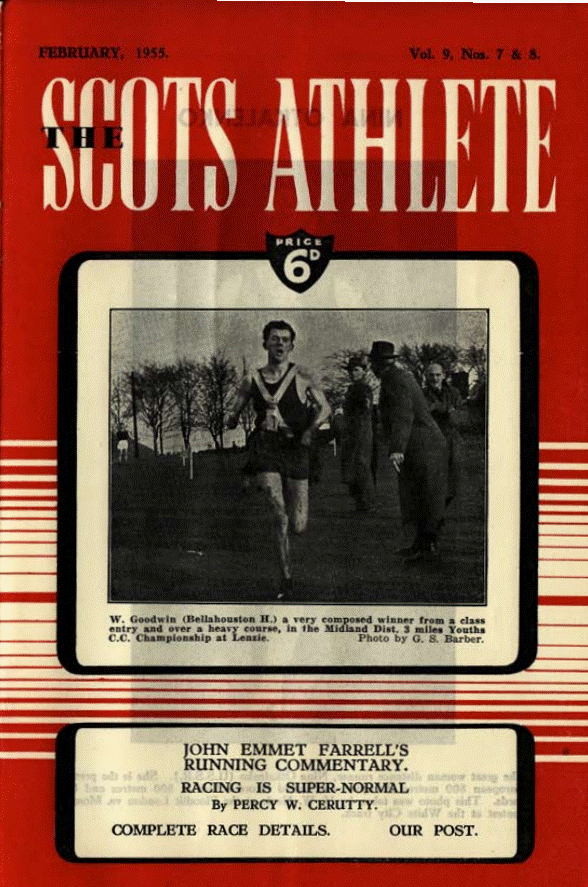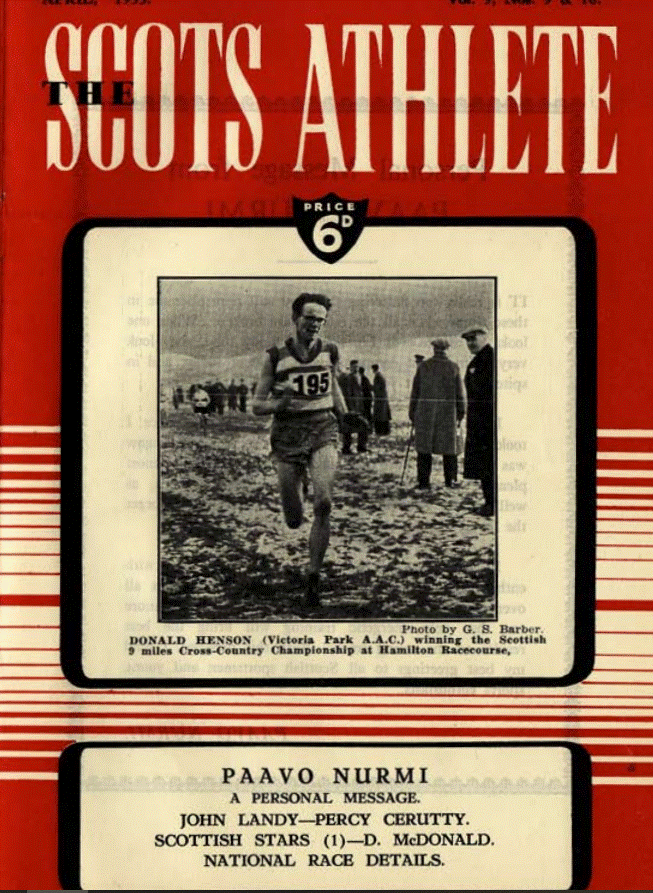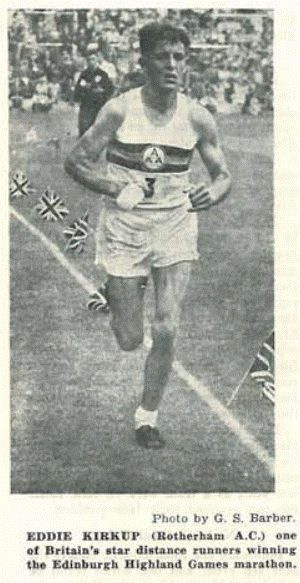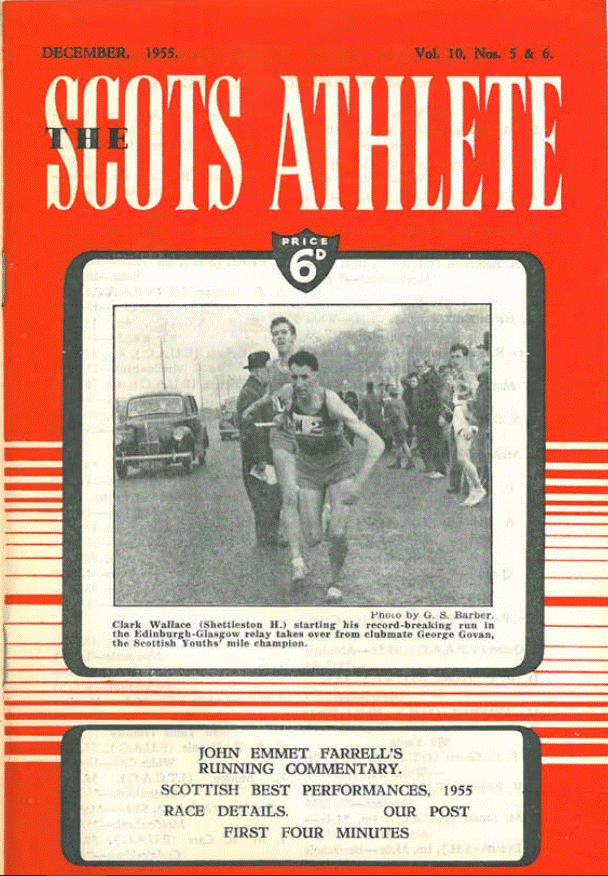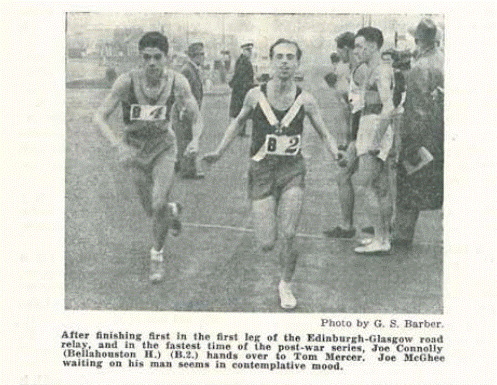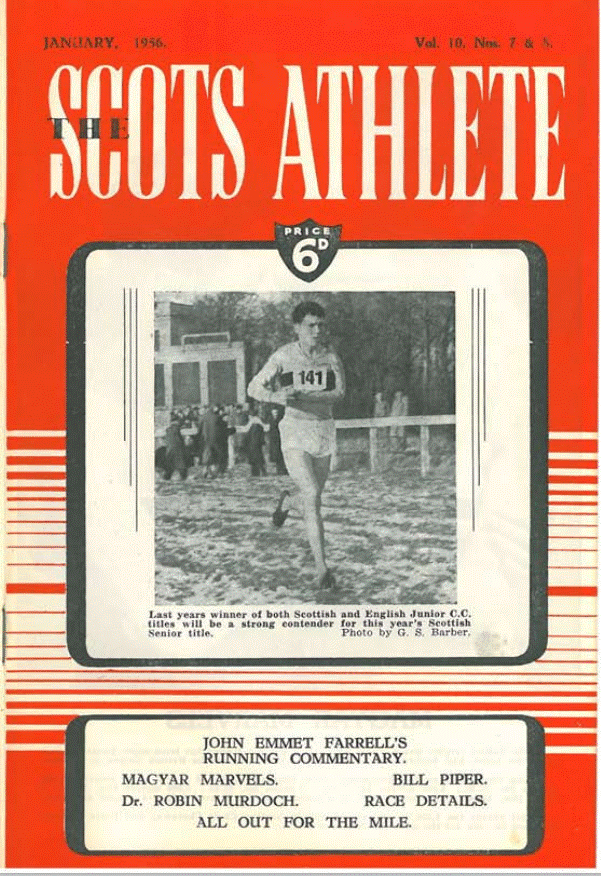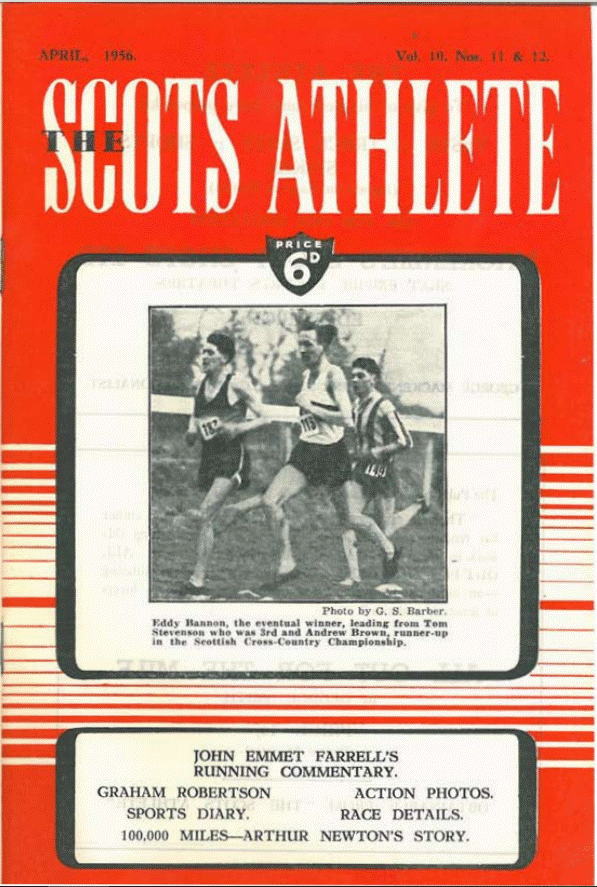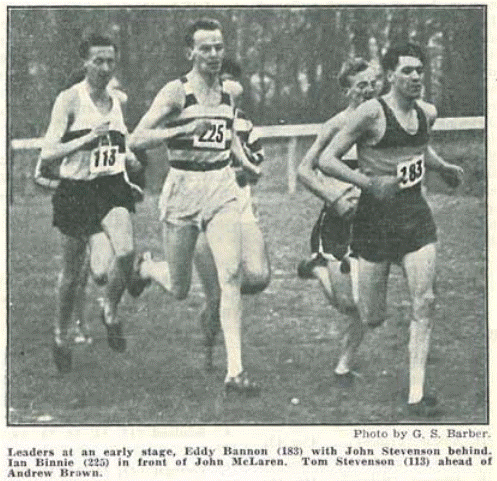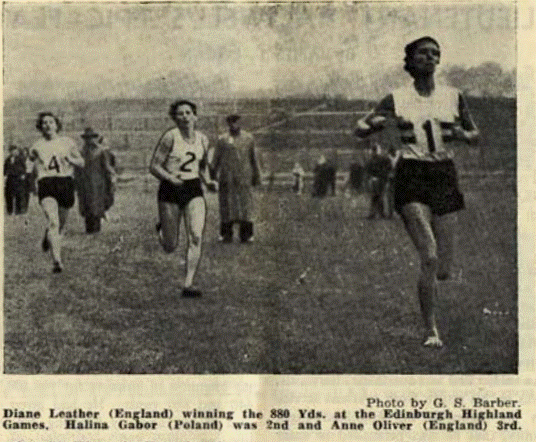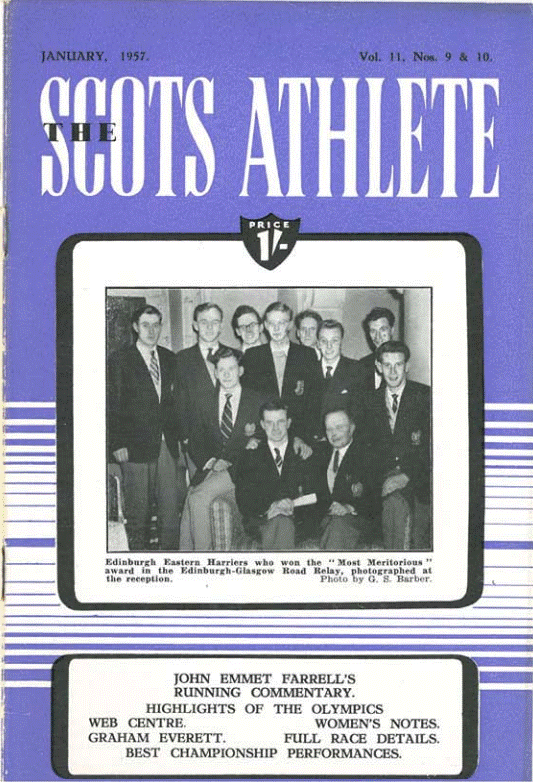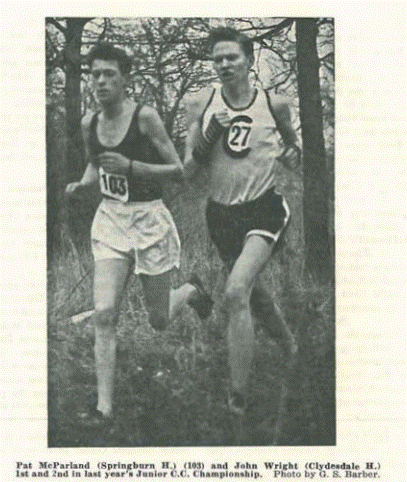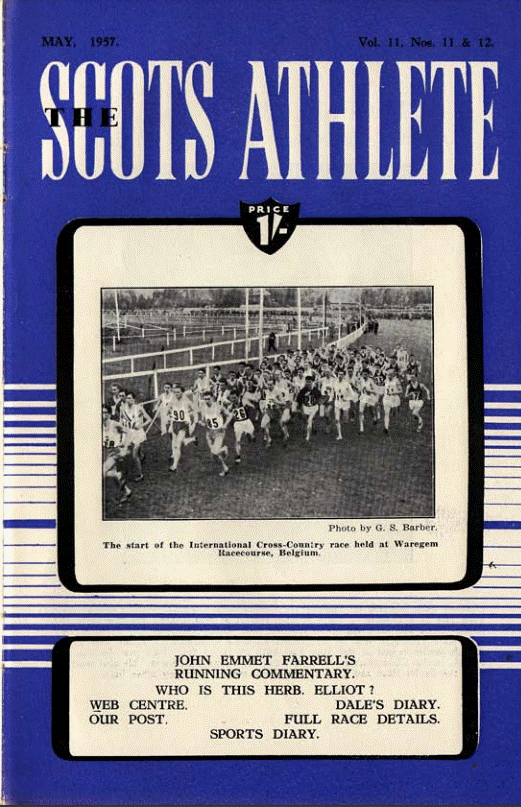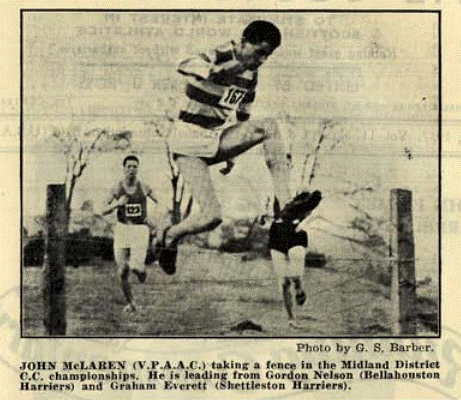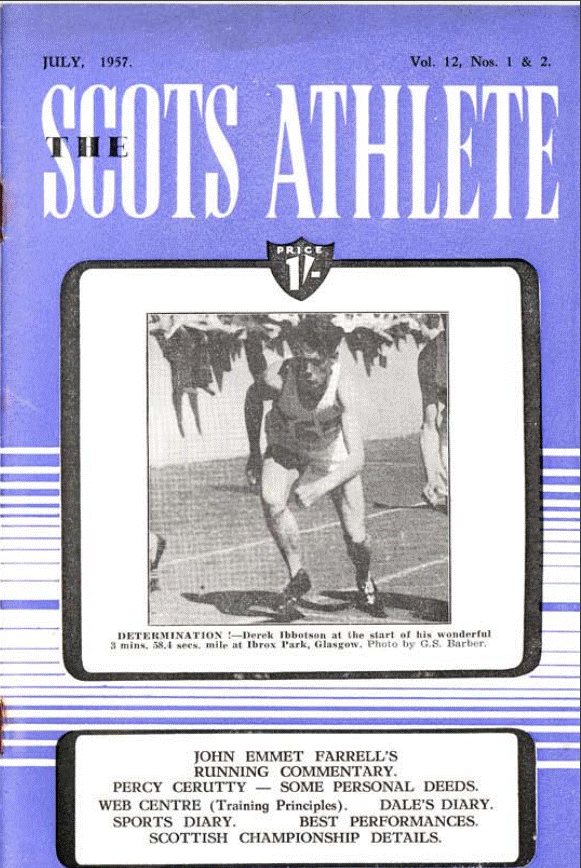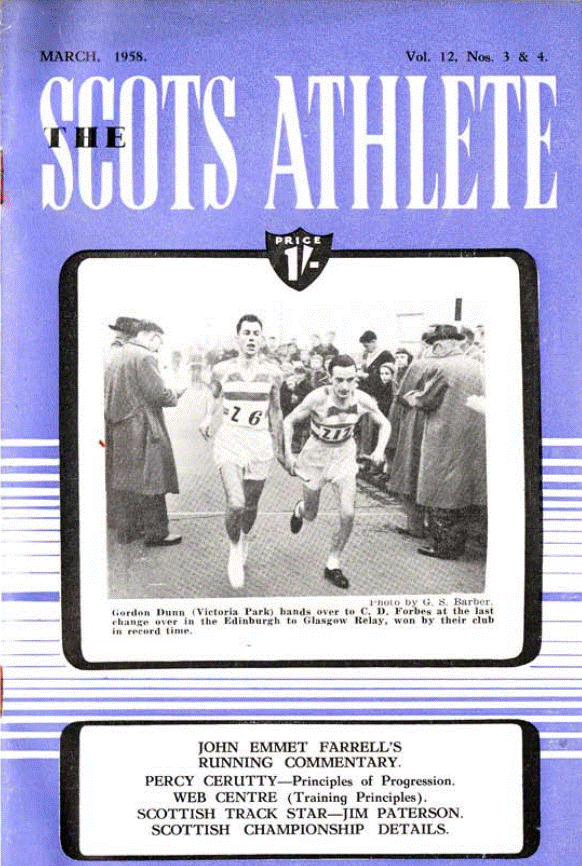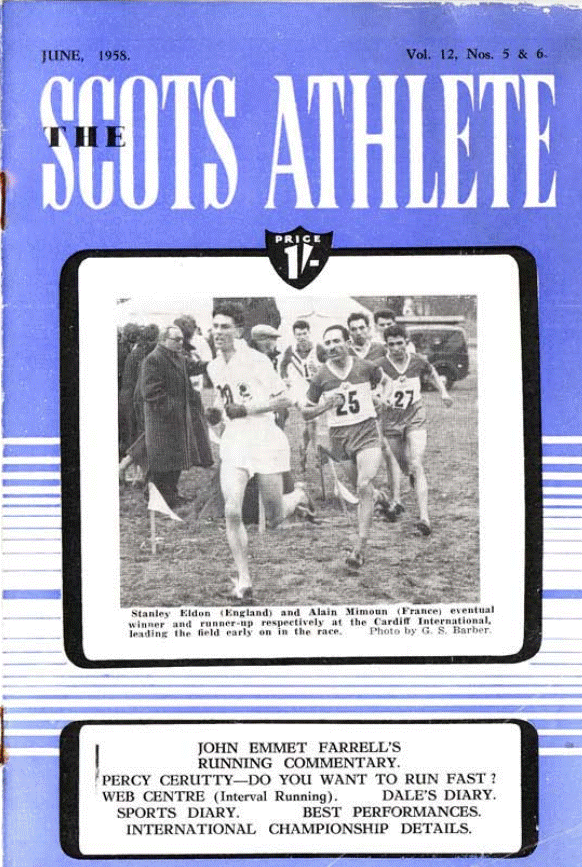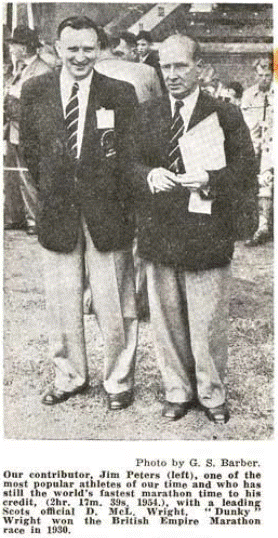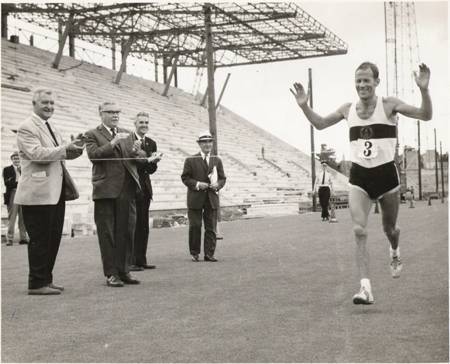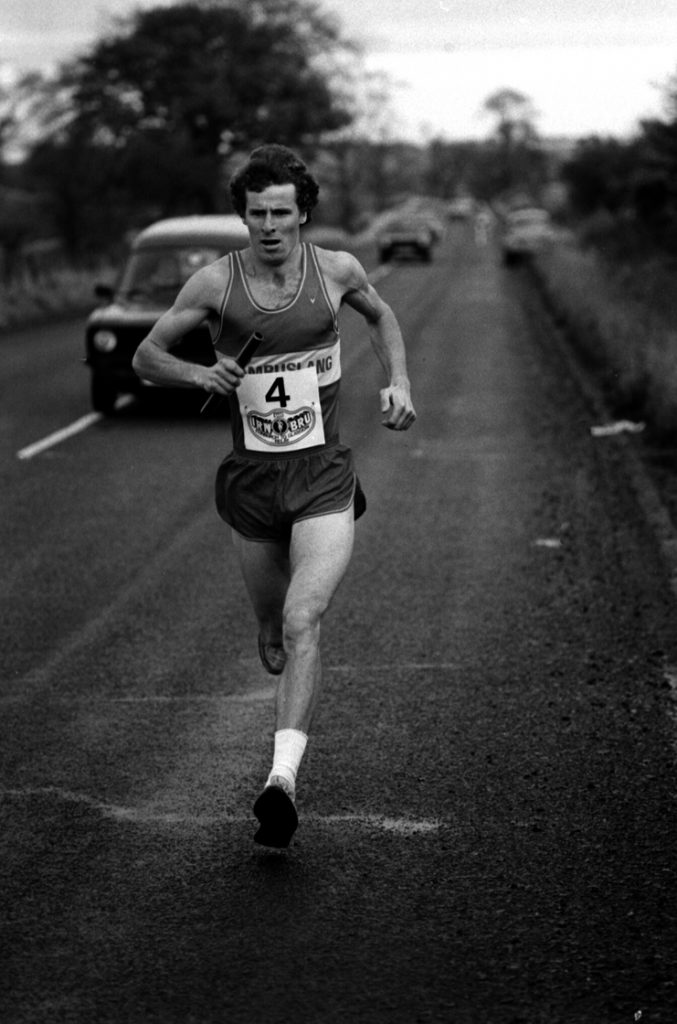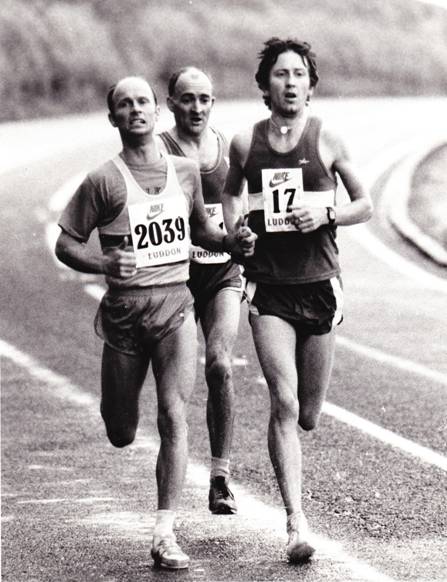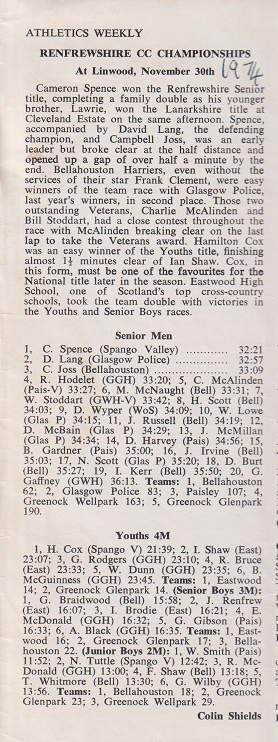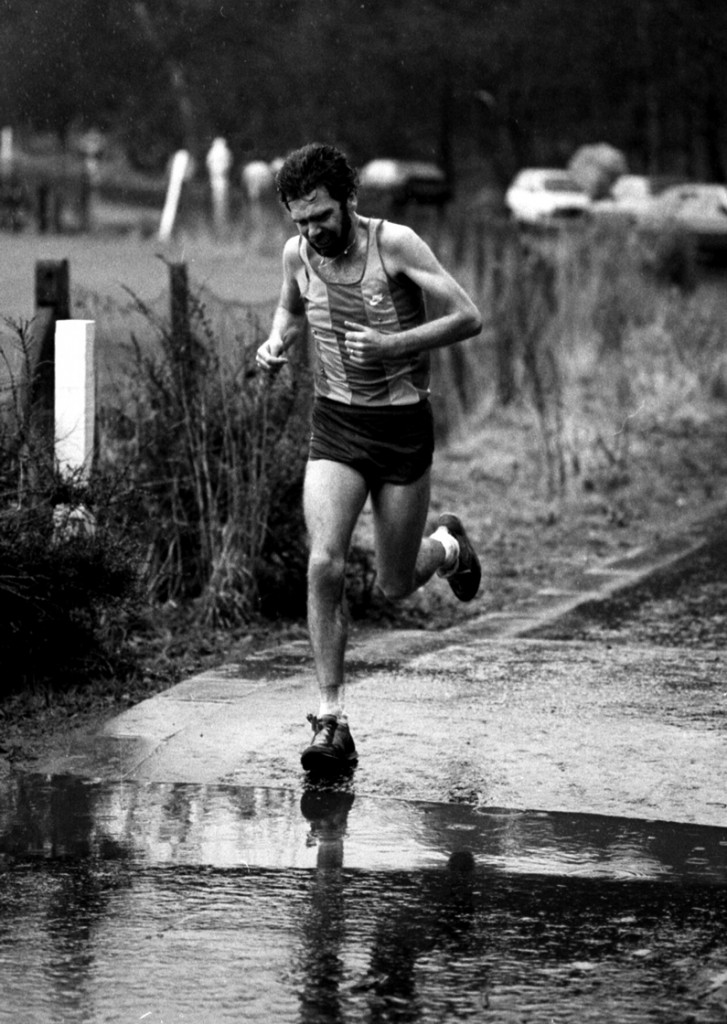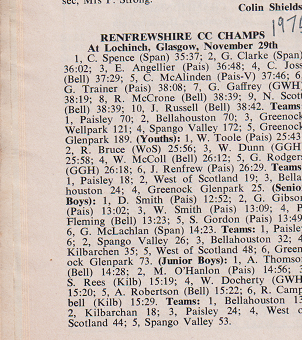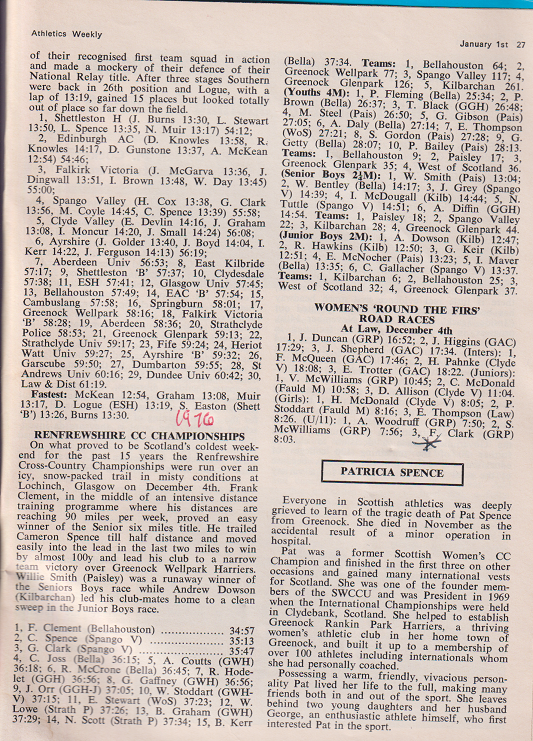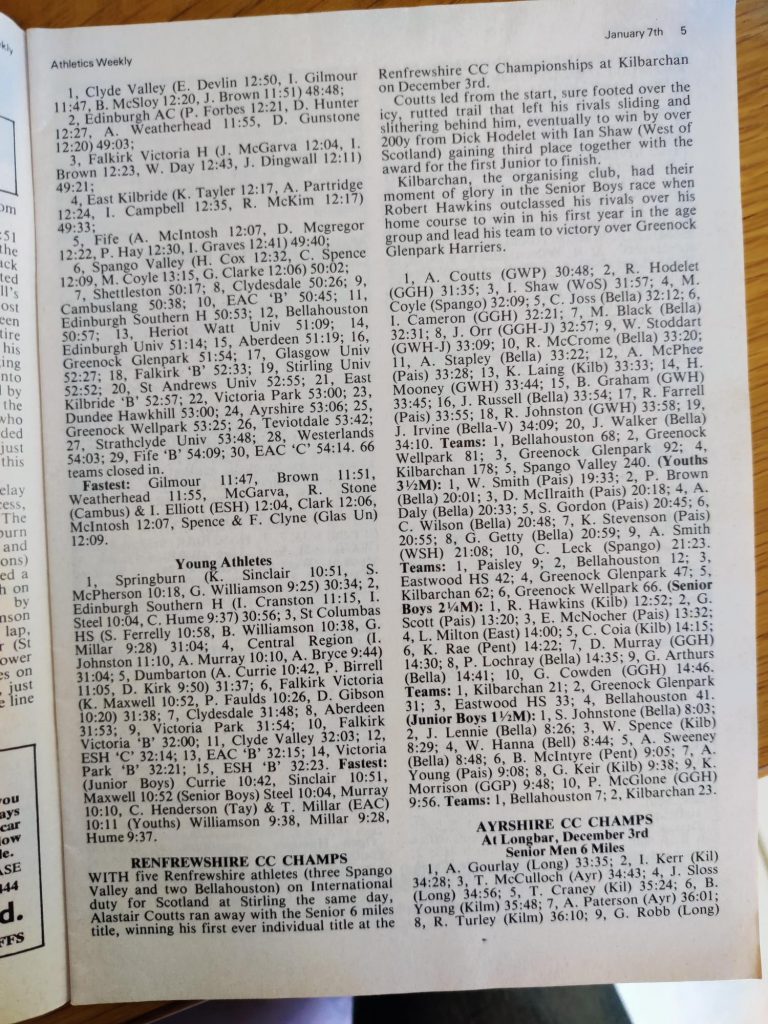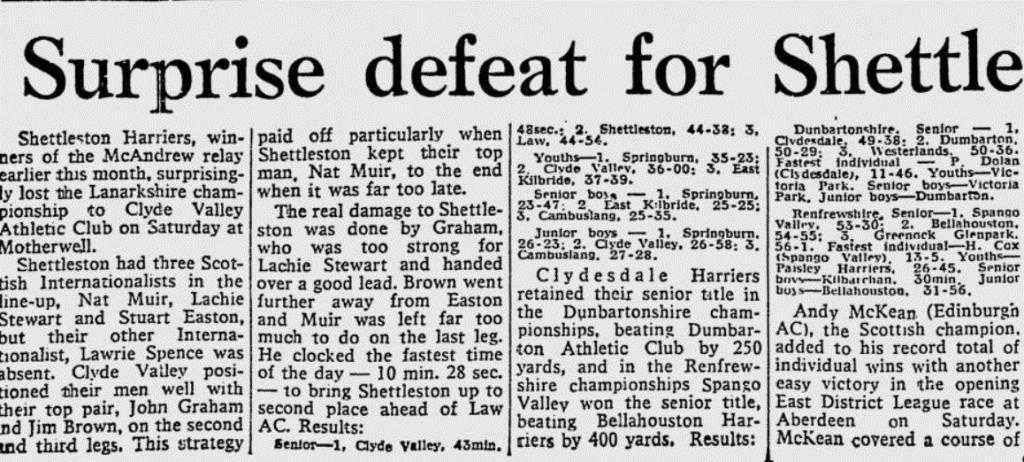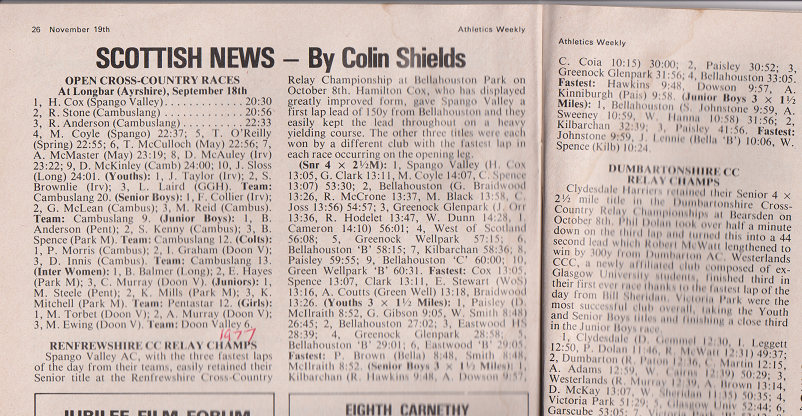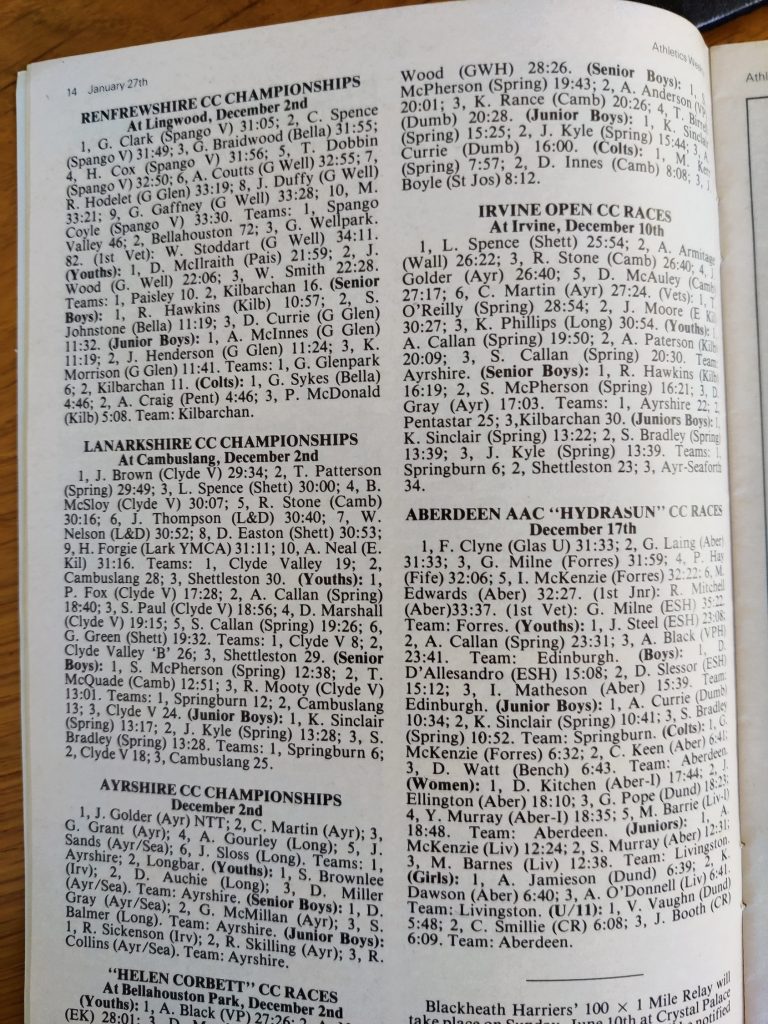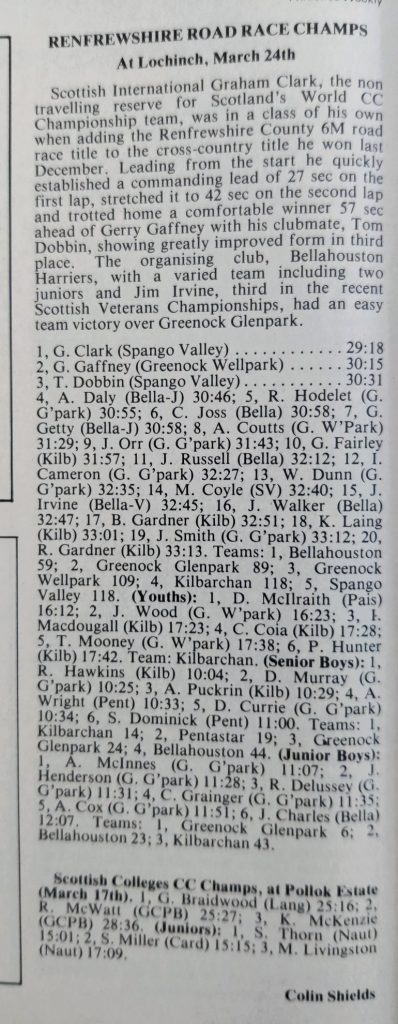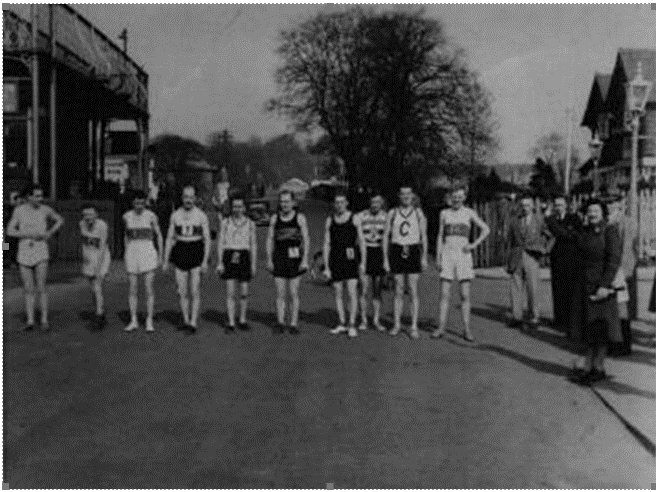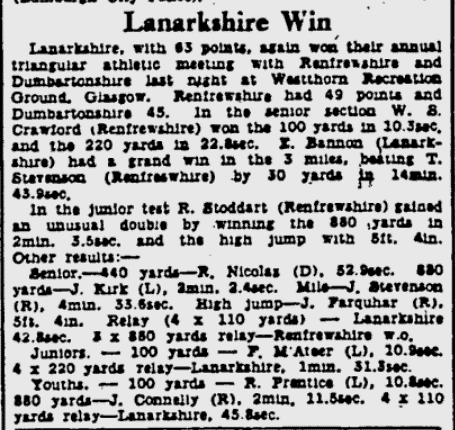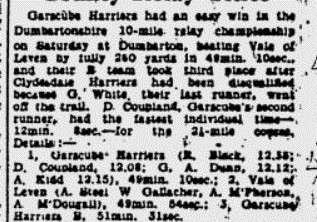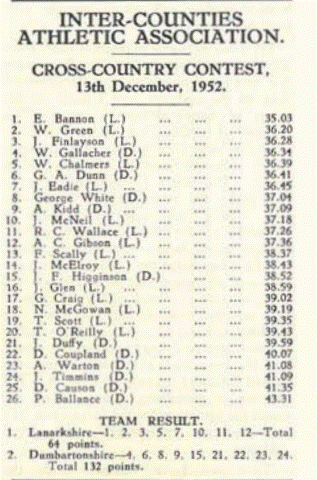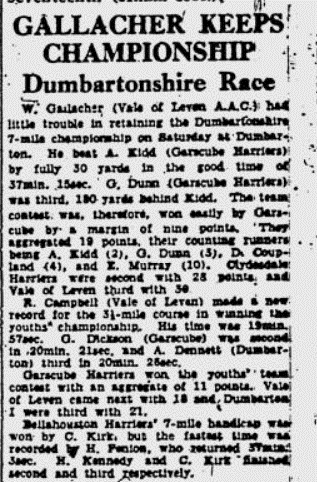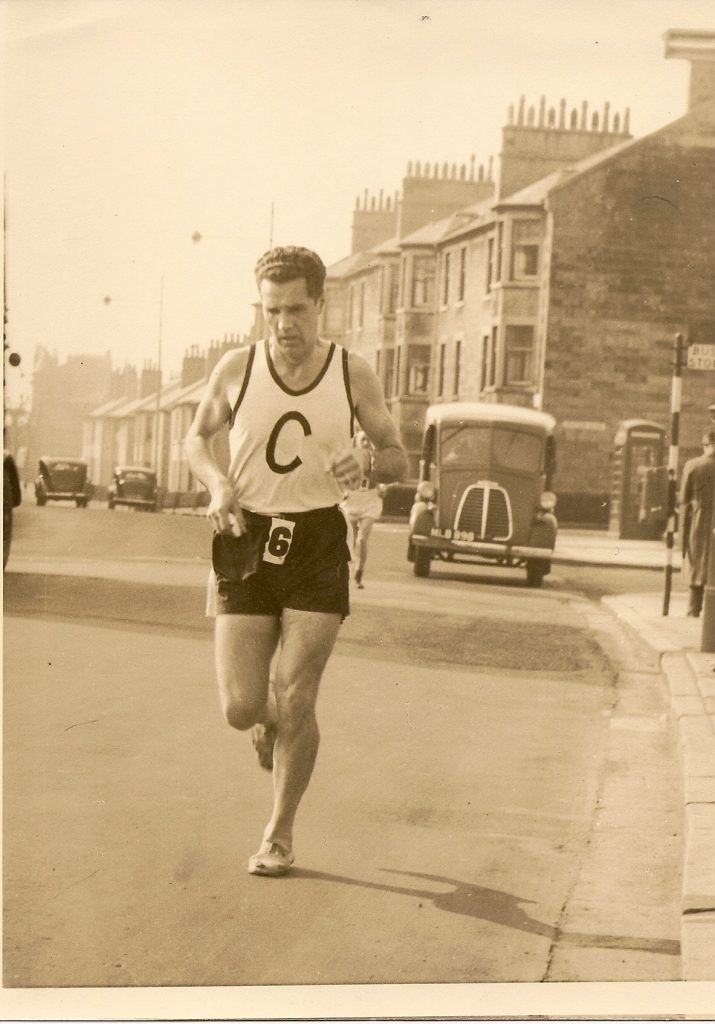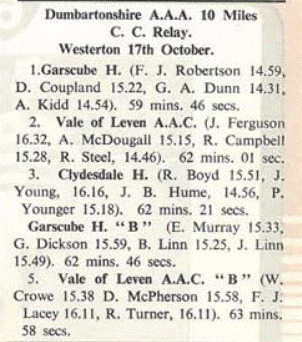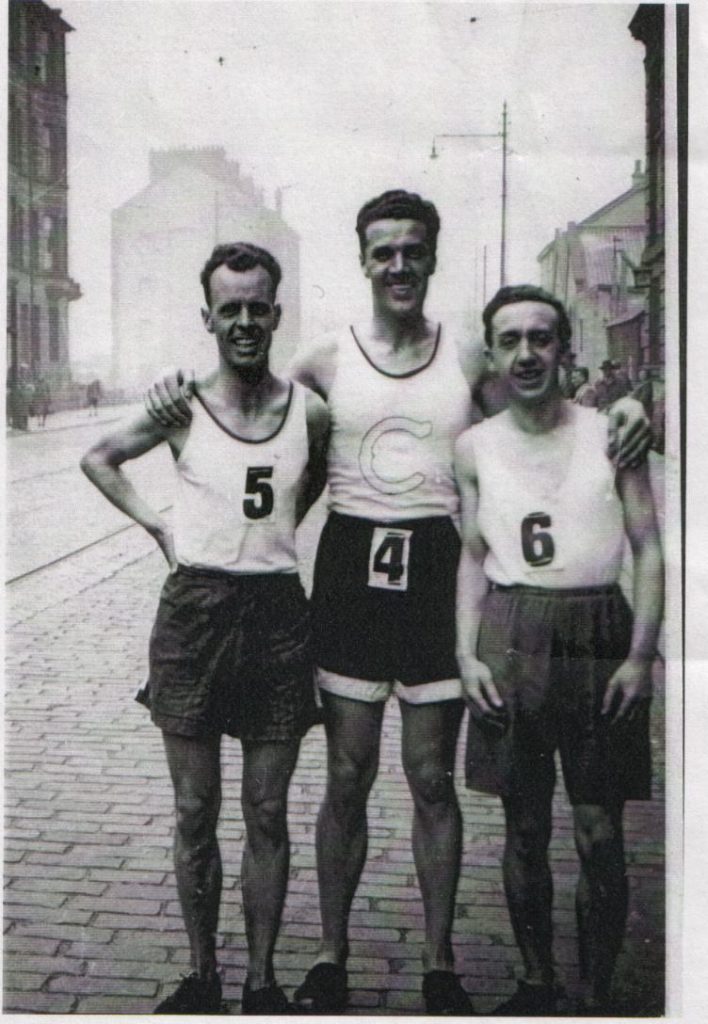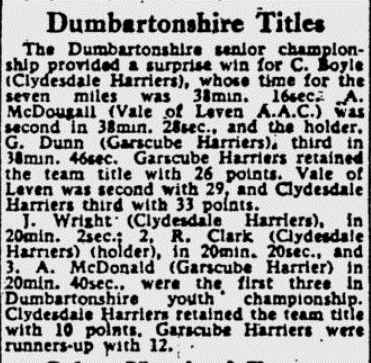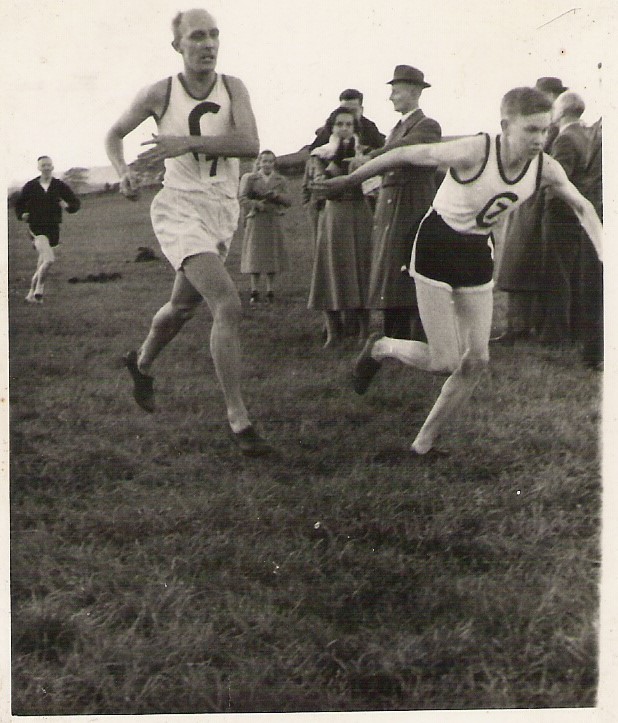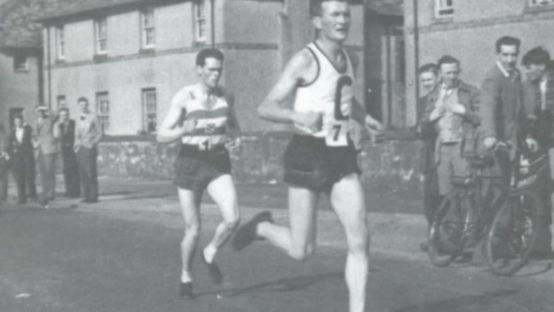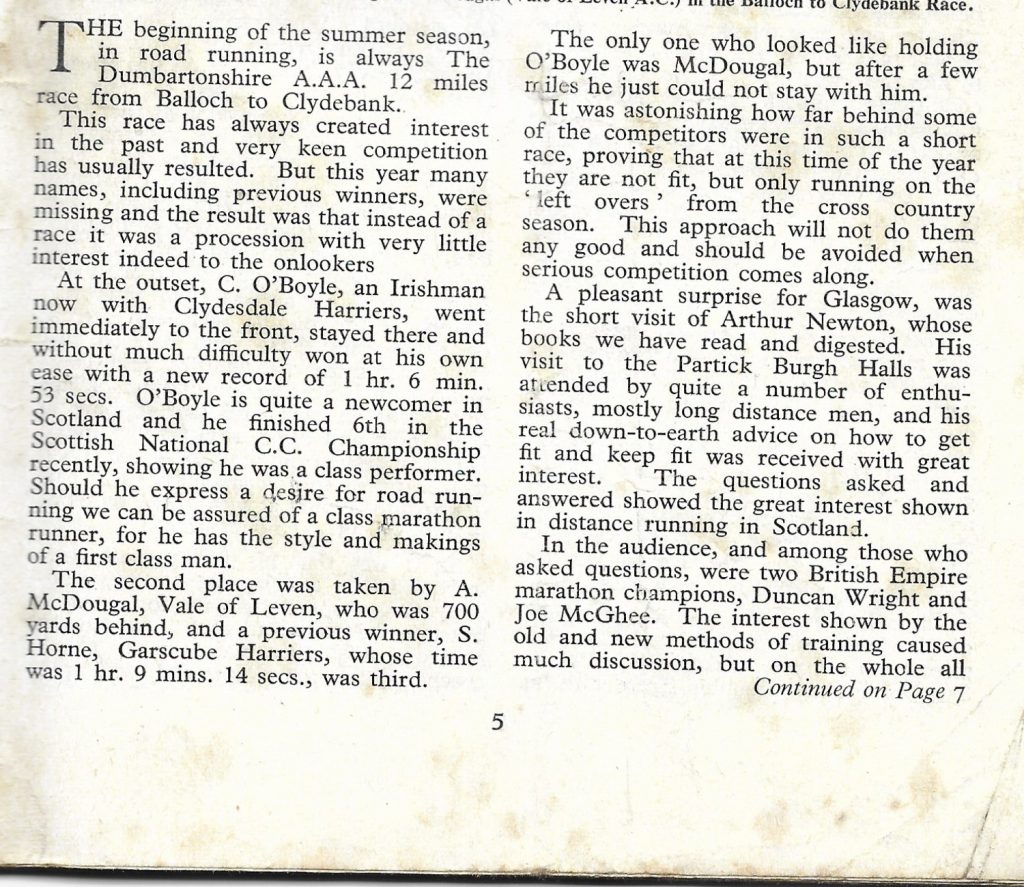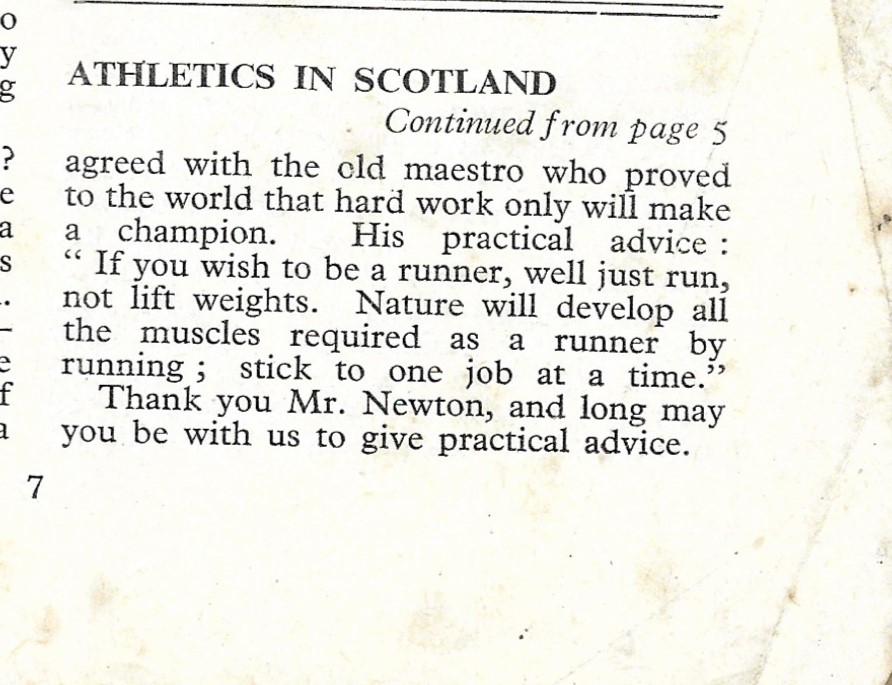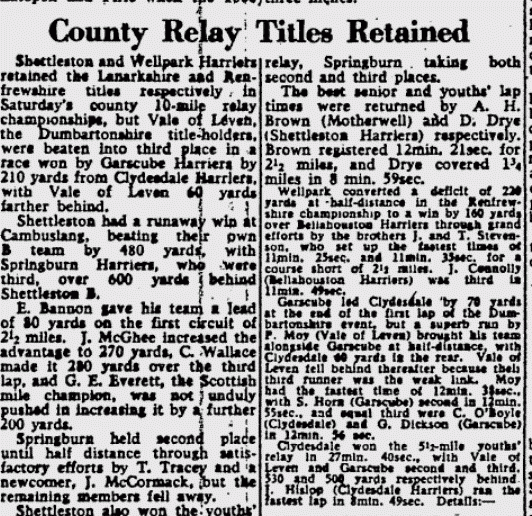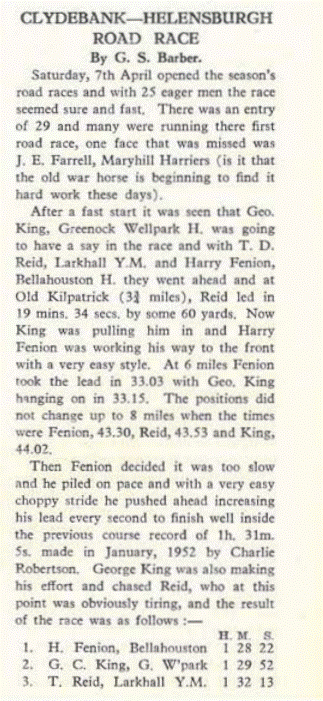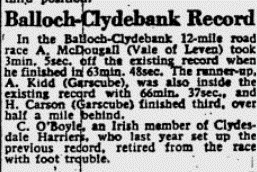The 1950’s was an unappreciated Golden Age for Scottish endurance running and this was exemplified by the standard in Dunbartonshire at the time. Pat Moy of Vale of Leven ran for Scotland in the International cross-country in 1956, 57 and 58, Alex McDougall, also Vale of Leven, was in the international of 1957 and the Empire Games of 1958, Cyril O’Boyle of Clydesdale was sixth in the National but, because of his Irish background, was not selected to run in the international, Pat Younger of Clydesdale was first reserve for the international, John Wright of Clydesdale was Junior Cross-Country Champion for two consecutive years, Alex Kidd of Garscube ran in the international in 1951 when there was only one international fixture on the calendar and only 8 were selected for it, Gordon Dunn of the same club ran in the 1956 international, while young Lachie Stewart of the Vale appeared on the scene in the latter years of the decade. Look for the names as we go through. We start with the 1957 road race season.
The Dunbartonshire County confined events in 1957 started in April with the road race that runners in other clubs wanted to see opened up: the Balloch 12.
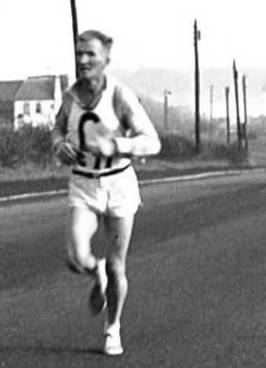
On 13th April, 1957, O’Boyle (above) and McDougall renewed their rivalry over the 12 miles from Balloch to Clydebank for the DAAA Road Running championship. It was a very good field with Willie Gallacher and George Dickson also starting.
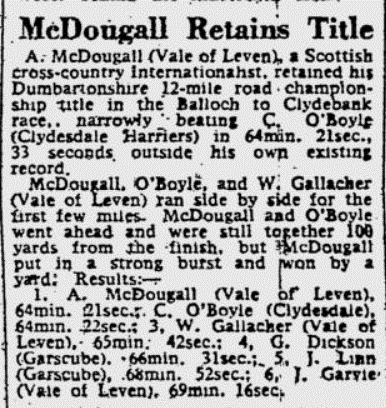
Two weeks later the annual Clydebank to Helensburgh 16 miles road race was held again with another good field and many top runners starting their long distance programme for the summer. The first three were all notable marathon runners, all Scottish international representatives and all hard competitors. Report and results:
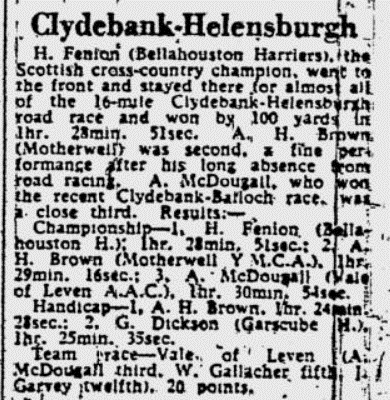
The Cross-Country 1957/58 season started with the relays on 19th October at and the report in the Glasgow Herald read:
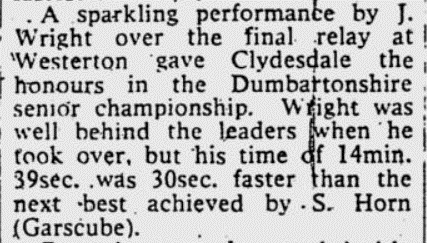
It was a remarkable victory – John Wright would go on to win the SCCU Cross-Country Championships twice after being second in his first run in the event, Jackie Hislop was in the same age group – a good runner but not as good as Wright. Ballance had run for Glasgow University and Oxford too but much preferred the road and track to country. The Vale team had three internationa class athletes in their four and were a formidable team. The complete results were as follows:
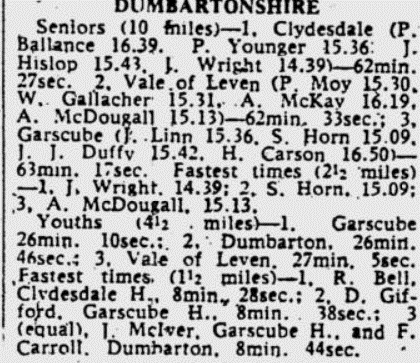
Alex McDougall is seen in the picture below (source unknown) wearing the Scottish colours and number 20 in the Empire Games at Cardiff in July 1958. He finished seventh of the 21 finishers in 2:29:58, the only Scot to finish, ahead of such as Ron Franklin of Wales, Arthur Kiely of England and Ray Puckett of New Zealand. That he was a quality athlete, there is no doubt.
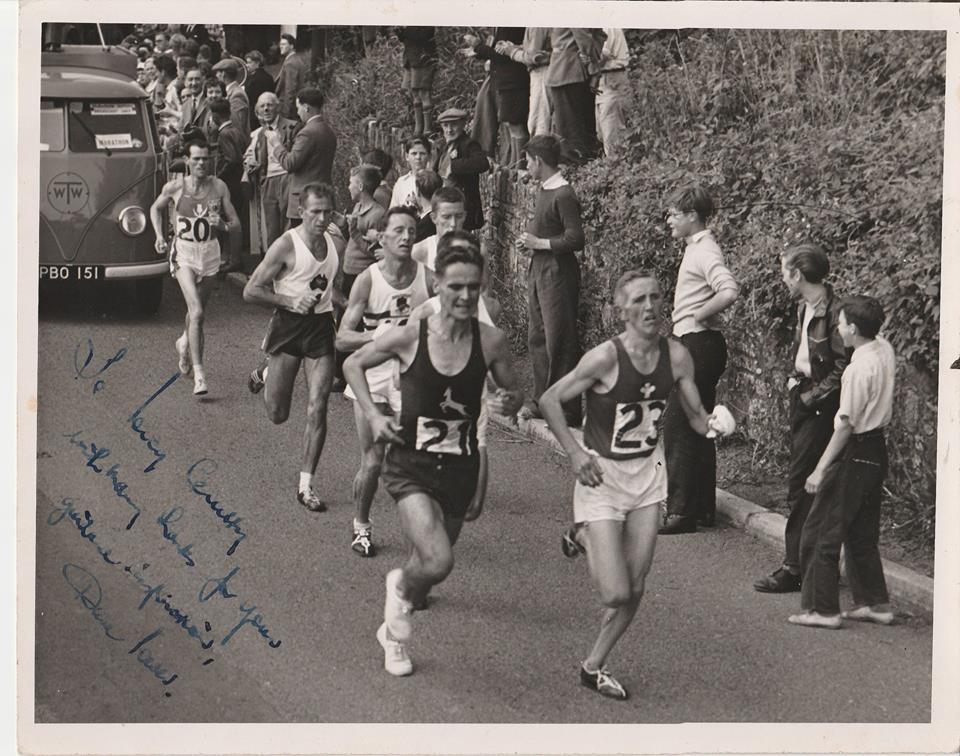
The actual individual and club championships took place on 14th December and Wright showed that his run in October was no fluke. The coverage of the race in the Glasgow Herald was quite complete. It was a remarkable event altogether – even if we ignore the Senior race which was dramatic in its own right – the names in the younger age group are significant. Doug Gifford, second in the Youths race would be Glasgow University and Scottish Universities cross-country champion before becoming a leading authority on Scottisg literature on a world wide platform, Bobby Bell went on to be a top-class coach specialising in the Hammer event, the winner of the Boys race was none other than Lachie Stewart of the Vale of Leven whose athletics future needs no further comment.
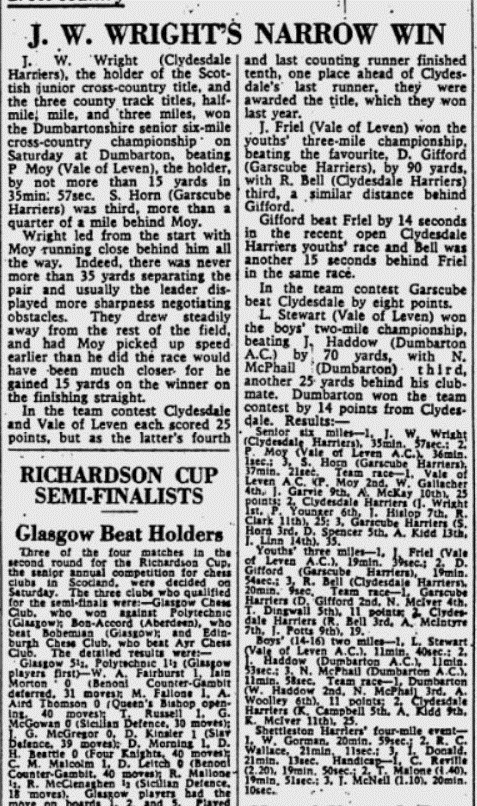
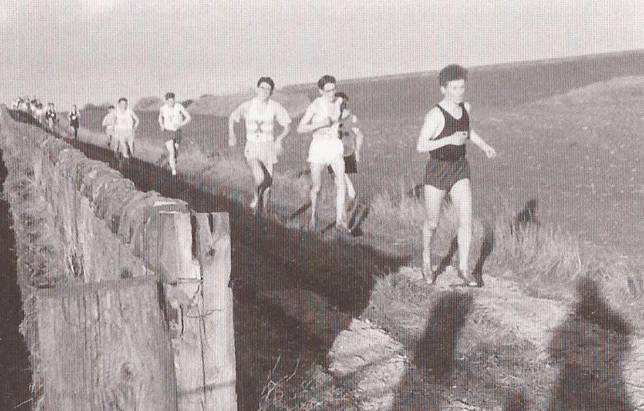
Douglas Gifford leading the field in the Scottish Universities Championships with Don Macgregor of St Andrews in fourth place.
Into 1958 and the first DAAA road race was again the Balloch to Clydebank on 12th April and the duel between O’Boyle and McDougall became a three man race when McDougall’s team mate Pat Moy joined the field. He had to set a new course record to do so but he was in good form – fit enough to qualify for the Empire Games later in the season.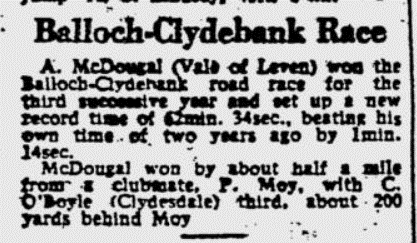
Then came the Clydebank to Helensburgh 16 exactly two weeks later won for the second year in succession by Bellahouston Harrier Harry Fenion who in 1957 had become the only man to win the Scottish Cross-Country Championships and SAAA Marathon title in the same year) in a new record time – but Alex McDougall was second and both, along with Shettleston’s Hugo Fox, would go to Cardiff in July. Result:
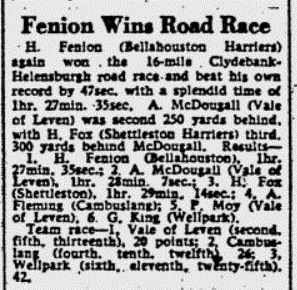
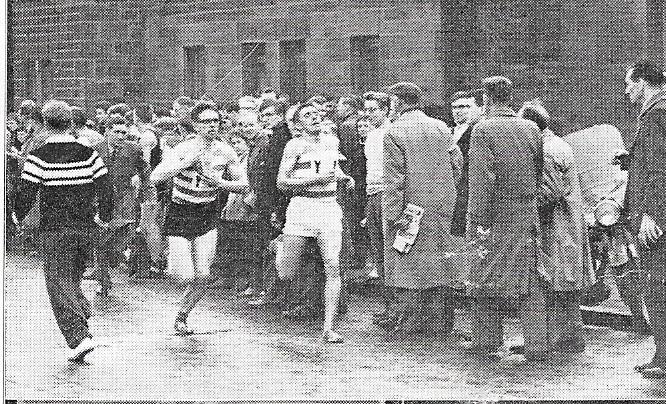
Pat Moy, right, passing the Edinburgh to Glasgow baton to Bob Steele
Coverage of the county championships were not available in the Press that summer, or most summers come to that, which is unfortunate given the quality of athlete in the four clubs that were contesting the events there. The following season, 1958/59, Wright lost his title but to team mate O’Boyle who won by approx 40 yards with Moy a similar distance behind Wright. Detailed results: 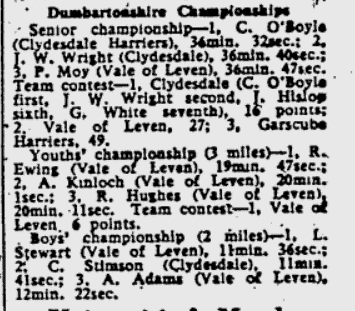
O’Boyle did not contest the Balloch to Clydebank in April 1959 but Wright did – and he like his team mate, finished second to McDougall. The report read as follows: A McDougall (Vale of Leven) had his fourth successive win in the Balloch – Clydebank road race over a shortened course, caused by a diversion at Dumbarton which cut about three-quarters of a mile off the usual 12 miles. His time of 60:40 was 1 min 54 sec faster than his record for the longer course. JH Wright (Clydesdale) was second, 300 yards behind McDougall, with P Moy (Vale of Leven) 150 yards behind Wright. A Weekes-Pearson (Blackheath Harriers), an English internationalist who could not take part as it was a confined event, started unofficially 3 minutres behind the runners and his time for the distance was only 5 sec outside McDougall’s time. Results:- 1. A McDougall (Vale of Leven) 60:40; 2. J Wright (Clydesdale) 61:40; 3. P Moy (Vale of Leven) 62:08; 4. G White (Clydesdale) 63:10; 5. E Barrowman (Garscube) 65:13; 6. R Hamill (Dumbarton) 67:32.
The appearance of Weekes-Pearson, who was with the Royal Navy on the Clyde at the time was unusual because as it was a confined event, guests were not usually permitted to run. There had been a desire by many athletes and officials, including the Scottish Marathon Club to hold it as an open race for several years but it was to continue as it was for several decades to come.
The next County road race was, unlike the Balloch event, an open race, and a popuar one. The Clydebank to Helensburgh on the 25th of the month when the winner for the previous two years and record holder, Harry Fenion was not present. It was nevertheless a good quality field with Empire Games representative Hugo Fox of Shettleston, Gordon Eadie of Cambuslang, like Fox a future SAAA Marathon champion, and Andy Brown, a top class track, cross-country and road runner who would hold the Scottish marathon record for a short time later in his career. Brown was to emerge the victor this time round. The Glasgow Herald report read.
“ROAD RECORD FOR A.H. BROWN
Clydebank-Helensburgh
AH Brown (Motherwell YMCA) beat the record for the Clydebank-Helensburgh 16-mile road race with a time of 1 hr 23 min 11 sec, 4 min 24 sec better than the time returned by H Fenion (Bellahouston Harriers when he won the event last year. Fenion was not in Saturday’s race but H Fox (Shettleston Harriers) and G Eadie (Cambuslang Harriers also were inside the previous best time with 1hr 24min 06sec, and 1hr 26min 39sec respectively. The team contest was won for Shettleston Harriers by H Fox, H Mitchell and W Gorman.”
We could have done with more detail on the race but there is enough there to let us know that it was a hard race if the first three were inside Harry’s record and Hughie Mitchell was unplaced. The thing about point-to-point races is that they can be seriously affected by the weather – the prevailing wind for this race was west to east and in the runners’ faces if there was one; there was one race in the 1960’s when the wind was blowing in the other direction and almost all runners had personal best times. No wind guages for road races!
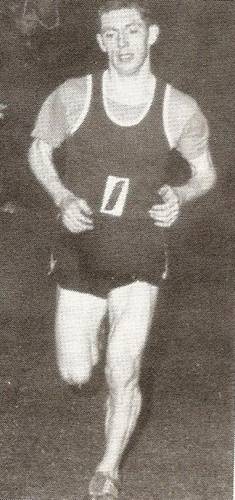
AH (Andy) Brown, Motherwell YMCA
The Cross-Country Relay in 1959/60 season were held on 17th October at Kirkintilloch and resulted in a victory for Vale of Leven over Clydesdale thanks mainly to the sterling work of Pat Moy. The report in the Glasgow Herald read as follows.
Dumbartonshire Title
The race for the Dumbartonshire senior relay title at Kirkintilloch, with race headquarters in St Ninian’s High School, was decided in the third relay of the 4 x 2 miles event when P Moy (Vale of Leven) gave his team mate W Gallacher a lead of 170 yards for the final circuit. Clydesdale Harriers, who had been in the lead until the half-distance, were beaten into second place, 100 yards behind Vale of Leven. DL Spencer (Garscube Harriers) was the fastest individual over the course, his time of 10 min. beat that of Moy and C O’Boyle (Clydesdale Harriers) by 4 sec. Results:-
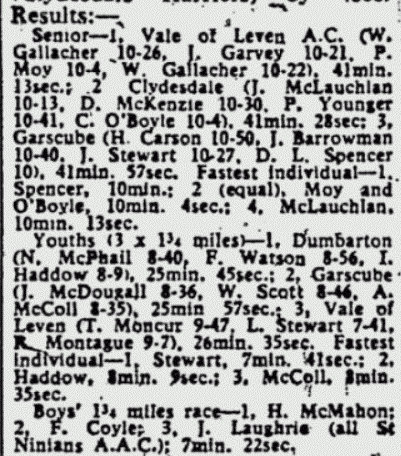
Note that the reporter headlines the report with the title ‘Dumbartonshire Title’ when the previous reports, and indeed all the DAAA documentation followed the lead of the County Council by referring to it as Dunbartonshire. Doctor McPhail, noted historian and proud citizen of Dumbarton was clearly of the opinion that the Dumbartonshire version was correct and made the point that such was the county title until the early 20th century when a decision was made to distinguish the one from the other by changing the name of the county. Several of the Youths Ian Haddow, Fraser Watson, Bob Montague would go on to have a decent senior career although none would be as glorious or as long as that of Lachie Stewart who had by far the fastest time over the race distance. Of the seniors, Dougie Spencer of Garscube was the county track 3 miles title holder and a very good all round distance runner.
The photograph below of Pat Younger clearly indicates the fact that cars were not for the many in 1959 – note the two team buses in the background parked beside the High School. There were more than two used by clubs that day.
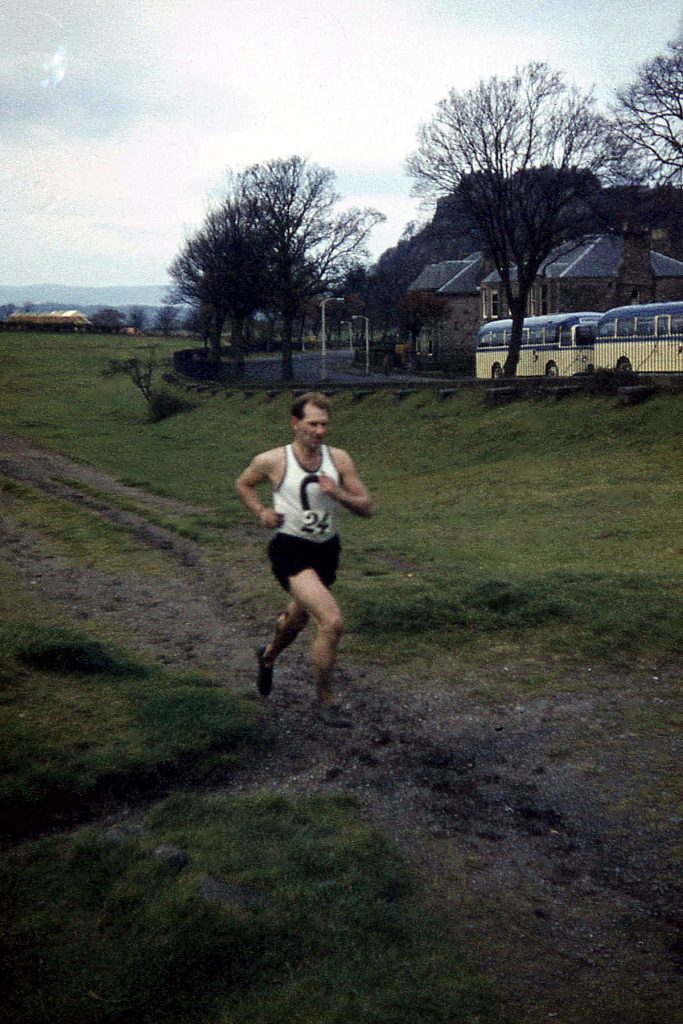
Pat Younger running the third stage for Clydesdale Harriers in the 1959 Relay championship.
12th December was the date for the County Cross-Country Championships in 1959, and Dumbarton was the venue. The course started on the Common from outside the Brock Baths which provided the changing accommodation and officials facilities. Glasgow Herald report below. The two W Gallachers for Vale of Leven is not a misprint – they were referred to locally as Willie Gallacher for the older of the two and Billy Gallacher for the younger!
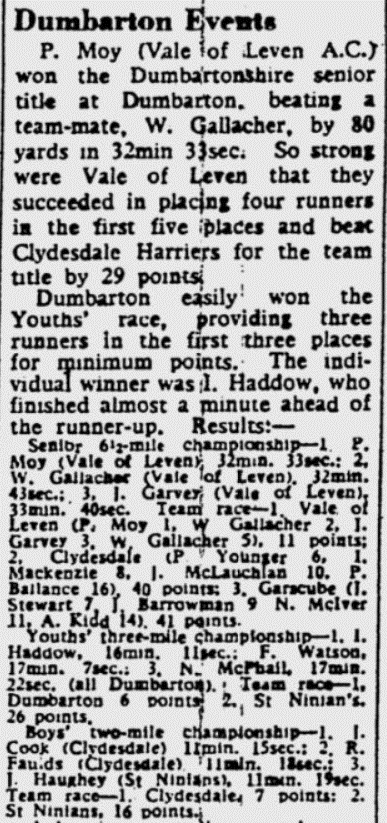
9th April 1960 saw the Balloch to Clydebank road race won by a distance by Cyril O’Boyle from John Barrowman of Garscube with Doug Spencer third. We read: “C O’Boyle (Clydesdale Harriers) beat J Barrowman (Garscube Harriers) by more than three-quarters of a mile in the Balloch to Clydebank 12-mile road race, winning in the slow time of 65 min 32 sec. D Spencer (Garscube) was third, 12 yards behind Barrowman. O’Boyle, who led from the start, was 200 yards ahead after three miles and he steadily increased his lead thereafter. W Gallacher (Vale of Leven), who was in second place after six miles) had to retire with foot trouble. Results:- 1. C O’Boyle (Clydesdale H) 65:32; 2. J Barrowman (Garscube H) 69:56; 3. D Spencer (Garscube) 70:03.”
The only result that we have for the Clydebank to Helensburgh on 23rd April, reads: “G Eadie (Cambuslang Harriers), who was third last year, won the Clydebank to Helensburgh 16-mile road race in 1 hr 23 min 32 sec.”
The lack of reporting at times was rather disappointing; even more so was the lack of information about the DAAA Track & Field Championships. However, we have the information above and the next section will deal with 1960/61 through to 1964/65.
….
